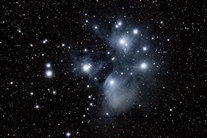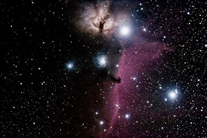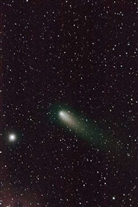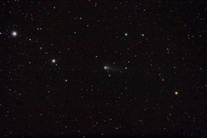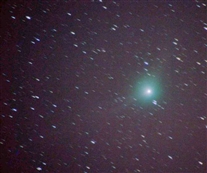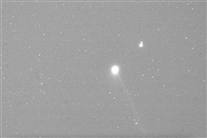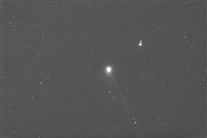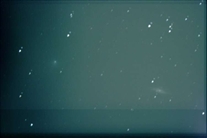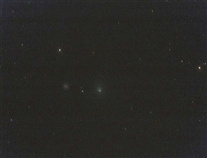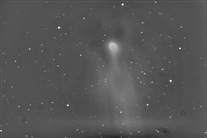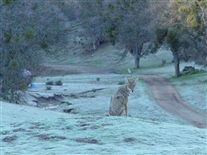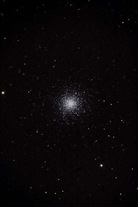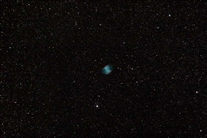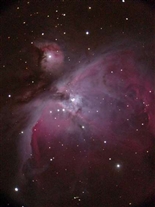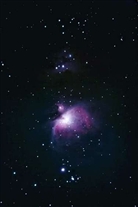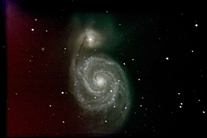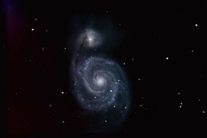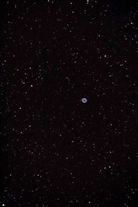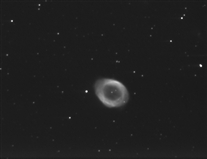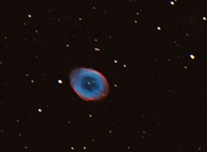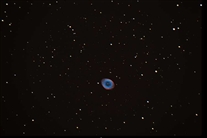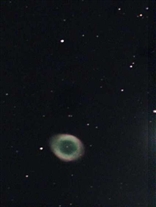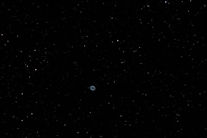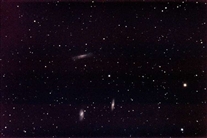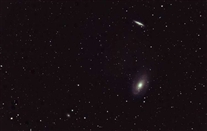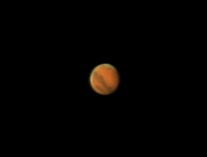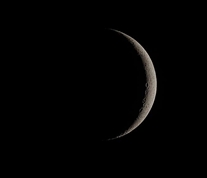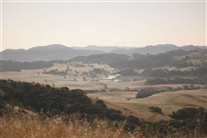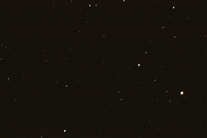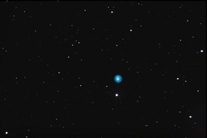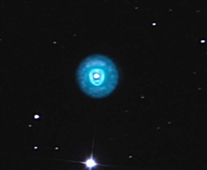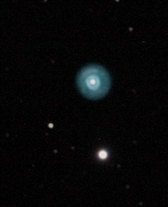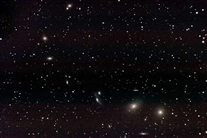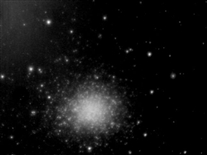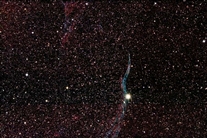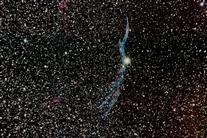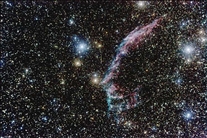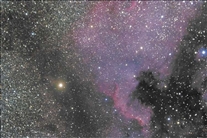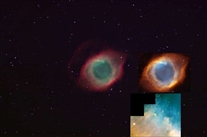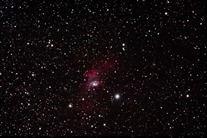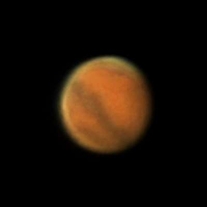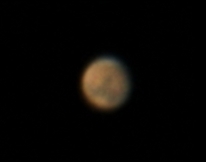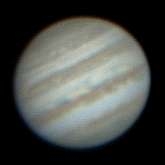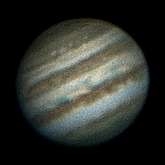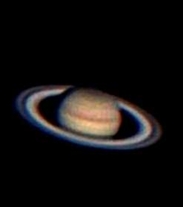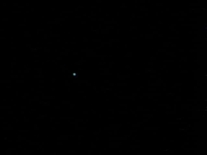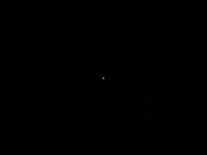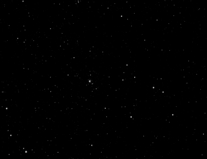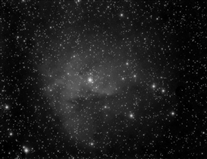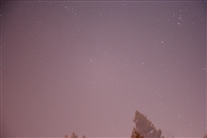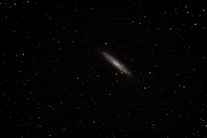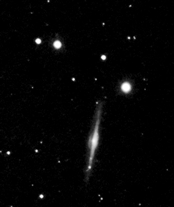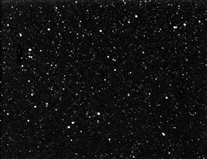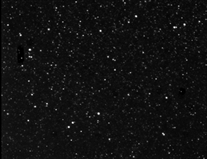thumbnails/m045_ed80f075_20d-nr_4x20minseciso1600_sigmed_ip-ddp2061.jpg M45 Pleides Cluster (Seven Sisters) (2006) - Dave Samuels |
|---|
| Acquisition Date | : | 08/27/2006, Fremont Peak, California | | Camera | : | Canon 20D unmodified about 54 degrees F | | Camera Settings | : | 4 cr2 raw frame -
4 x 20min 1600ISO RAW, with save to PC and convert upon download. Also included JPG, which I like to do so I can check on things without having to do a lot of processing.
Darks, flats and bias taken just before sunrise.
In-camera noise reduction ON
Mirror lock off | | Telescope/Optics | : | 600mm f/7.5 Orion ED80. | | Mount | : | AP1200 2006 series
guided through Orion ST80 (400mm f/5.0) with DSI IIc, GPUSB shoestring, MaximDL
| | Adapter / Prime / Afocal / Other | : | None
North is up in this image, though it was to the left in the source images due to the way I have to place the camera on the mount, | | Weather/Conditions | : | Clear - seeing was as good. | | Processing Package / Processing Applied | : | Manually focused using IP fwhm focus data. Captured using Images Plus 2.75 for focus/capture/calibrate/align/stack averaged. | | Web Site | : | www.davesamuels.com | | NOTES | : | M45 is located at RA 3h 46.807m, DEC +24deg 11.355' (J2000)
Notice the small galaxy just to the right of Electra (on the right side of the image RA 3h 43.742m, DEC +24deg 3.644'). It is UGC 2838 at 17.29 mag (StarryNight - 17.89 by other accounts). |  m042_55_140mmf070_20d-nr_120SecISO800_10xSigMed_ip-crop-ddp2114-astrotools.jpg
M42 - The Great Orion Nebula M42 - The Great Orion Nebula
Messier 42 is a starforming Nebula M42 (NGC 1976), an emission and reflection nebula, with Open Star Cluster, in the constellation Orion.
Right Ascension 05 : 35.4 (h:m)
Declination -05 : 27 (deg:m)
Distance 1.3 (kly)
Visual Brightness 4.0 (mag)
Apparent Dimension 85x60 (arc min)
Taken with TEC 140mm f/7.0. Canon 20D with in-camera noise reduction at 800iso. 10x2min images registered and stacked in ImagesPlus and tweaked in PS.
Temperature was about 55 degrees and dropping.
Excerpt from seds.org:
Of the hundreds or possibly thousands of images I've taken of this object, this image is by far the best quality and detail of them all to date.
The Orion Nebula was possibly discovered 1610 by Nicholas-Claude Fabri de Peiresc.
Independently found by Johann Baptist Cysatus in 1611.
Trapezium cluster found as multiple star by Galileo Galilei in 1617.
The Orion Nebula Messier 42 (M42, NGC 1976) is the brightest starforming, and the brightest diffuse nebula in the sky, and also one of the brightest deepsky objects at all. Shining with the brightness of a star of 4th magnitude, it is visible to the naked eye under moderately good conditions, and rewarding in telescopes of every size, from the smallest glasses to the greatest Earth-bound observatories as well as outer-space observatories like the Hubble Space Telescope. It is also a big object in the sky, extending to over 1 degree in diameter, thus covering more than four times the area of the Full Moon.
As it is so well visible to the naked eye, one may wonder why its nebulous nature was apparently not documented before the invention of the telescope. Only some Central American, Mayan folk tales may be interpreted in a way suggesting that these native Americans may have known of this nebulous object in the sky (O'Dell 2003, p. 3). However, the brightest stars within the nebula were noted early and cataloged as one bright star of about fifth magnitude: In about 130 AD, Ptolemy included it in his catalog, as did Tycho Brahe in the late 16th century, and Johann Bayer in 1603 - the latter cataloging it as Theta Orion in his Uranometria. In 1610, Galileo detected a number of faint stars when first looking at this region with his telescope, but didn't note the nebula. Some years later, on February 4, 1617, Galileo took a closer look at the main star, Theta1, and found it to be triple, at his magnification of 27 or 28x, again not perceiving the nebula.
The Orion Nebula was probably discovered in late 1610, when Nicholas-Claude Fabri de Peiresc (1580-1637), a French lawyer, turned his telescope to this region of the sky, and reported of a cloudy nebulosity. This sighting, however, was not published, but only reported in Peiresc's personal documents and brought up only by Bigourdan (1916). It was independently found in 1611 by the Jesuit astronomer Johann Baptist Cysatus (1588-1657) of Lucerne who compared it to a comet he had observed in the year 1618 (Cysat 1619). This work also did not get widely known, and opnly turned up by Rudolf Wolf in 1854 (Wolf 1854). The first known drawing of the Orion nebula was created by Giovanni Batista Hodierna, who included three stars; these are probably Theta1 as well as Theta2A and Theta2B. All these discoveries apparently got lost for some time, so that eventually Christian Huygens was longly credited for his independent rediscovery in 1656, e.g. by Edmond Halley who included it in his list of six "nebulae" (Halley 1716), by Jean-Jacques d'Ortous de Mairan in his nebulae descriptions, by Philippe Loys de Chéseaux in his list, by Guillaume Legentil in his review, and by Charles Messier when he added it to his catalog on March 4, 1769.
It is somewhat unusual that the Orion Nebula has found its way into Messier's list, together with the bright star clusters Praesepe M44 and the Pleiades M45; Charles Messier usually only included fainter objects which could be easily taken for comets. But in this one night of March 4, 1769, he determined the positions of these wellknown objects, (to say it with Owen Gingerich) `evidently adding these as "frosting" to bring the list to 45', for its first publication in the Memoires de l'Academie for 1771 (published 1774). One may speculate why he prefered a list of 45 entries over one with 41; a possible reason may be that he wanted to beat Lacaille's 1755 catalog of southern objects, which had 42 entries. Messier measured an extra position for a smaller northeastern portion, reported by Jean-Jacques d'Ortous de Mairan previously in 1731 as a separate nebula, which therefore since has the extra Messier number: M43.
As the drawings of the Orion Nebula known to him did so poorly represent Messier's impression, he created a fine drawing of this Object, in order to "help to recognize it again, provided that it is not subject to change with time" (as Messier states in the introduction to his catalog).
This gorgeous object continued to influence astronomers since. It was the first deepsky observation by William Herschel with a self-constructed reflecting telescope of 6-foot focal length in 1774. In 1789, with some prophetic touch, he described his observations with his 48-inch aperture, 40-foot FL scope as "an unformed fiery mist, the chaotic material of future suns."
The gaseous nature of the Orion Nebula was revealed in 1865 with the help of spectroscopy by William Huggins. On September 30, 1880, M42 was the first nebula to be successfully photographed, by Henry Draper. Consequently, on March 14, 1882, Henry Draper obtained a second, better, deeper, and more detailed photograph of the Orion Nebula, a 137-minutes exposure, which also clearly shows M43.
The Orion Nebula is located at a distance of about 1,600 (or perhaps 1,500) light-years. At this distance, its angular diameter of 66x60 arc minutes corresponds to a linear diameter of about 30 light-years. On its northern end, the nebula is devided by a conspicuous dark lane, well visible in our photograph. This image was obtained David Malin of the Anglo-Australian Observatory. More information on this image is available.
The detached northeastern portion is the nebula M43 first reported by De Mairan, and listed as a separate nebula by Charles Messier. Like the main nebula M42, this is an emission nebula, shining by the light emitted from its atoms, after being excited by the high-energy radiation of massive, very hot young stars within it. In the very neighborhood, to the north, there are also fainter reflection nebulae, partially reflecting the light of the Great Nebula. They were not notable for Charles Messier, but labeled later with the NGC numbers 1973, 1975, and 1977: NGC 1977 had been found by William Herschel (his H V.30), while NGC 1973 and NGC 1975 are discoveries of Heinrich Ludwig d'Arrest. Here we have a collection of more images of M42, M43, and more images of M42, M43 and NGC 1973-5-7.
The Orion Nebula is the brightest and most conspicuous part of a much larger cloud of gas and dust which extends over 10 degrees well over half the constellation Orion. The linear extend of this giant cloud is well several hundreds of light-years. It can be visualized by long exposure photos (see e.g. Burnham) and contains, besides the Orion nebula near its center, the following objects, often famous on their own: Barnard's Loop, the Horsehead Nebula region (also containing NGC 2024 = Orion B), and the reflection nebulae around M78. Already impressive in deep visible light photographs, the Orion Cloud is particularly gorgeous in the infrared light.
M42 itself is apparently a very turbulent cloud of gas and dust, full of interesting details, which Charles Robert O'Dell has compared to the rich topography of the Grand Canyon in his HST photo caption. The major features got names on their own by various observers: The dark nebula forming the lane separating M43 from the main nebula extends well into the latter, forming a feature generally nicknamed the "Fish's Mouth". The bright regions to both sides are called the "wings", while at the end of the Fish's Mouth there's a cluster of newly formed stars, called the "Trapezium cluster". The wing extension to the south on the east (lower left in our image) is called "The Sword", the bright nebulosity below the Trapezium "The Thrust" and the fainter western (right) extension "The Sail". Here we have a small collection of Images of detail in M42, including another nomenclature for the brightest region in the nebula by historic visual observers, as well as a pictorial study of the Trapezium cluster and region by Lowell Observatory images.
The Trapezium Cluster is among the very youngest (open) clusters known, with new stars still forming in this region. As stated above, the cluster was first depicted as triple star on February 4, 1617 by Galileo, who was not aware of the nebula. Galileo's discovery did not get widely known, so that Christian Huygens independently rediscovered the triple star in 1656 together with the Orion Nebula. These first three stars are often labelled "A", "C", and "D". It may be of interest that in both cases, the Trapezium, or Theta1 Orionis, was second to only one other double star: Mizar (Zeta Ursae Majoris). The fourth Trapezium star, "B", was first found by Abbe Jean Picard in 1673 (according to De Mairan), and independently by Huygens in 1684. The fifth cluster star "E" was discovered by Friedrich Georg Wilhelm Struve in 1826 with a 9.5-inch refractor in Dorpat, the sixth, "F", by John Herschel on February 13, 1830, the seventh, "G", by Alvan Clark in 1888 when testing his 36-inch refractor of Lick Observatory, and the eighth, "H" by E.E. Barnard later in 1888 with the same telescope. Barnard later found that "H" is double, with two 16th-magnitude components. Today we know that stars "A" and "B" are both eclipsing variables of Algol type: A (also known as V1016 Ori) was discovered in 1975 to vary between magnitudes 6.73 and 7.53 with a period of 65.4325 days, while B (also cataloged as BM Ori) varies between mag 7.95 and 8.52 in 6.4705 days, and is always the faintest of the four Trapezium stars.
The past decades of research on the Orion Nebula have revealed that the visible nebula, M42, the blister of hot, photo-ionized, luminous gas around hot Trapezium stars, is only a thin layer lying on the surface of a much larger cloud of denser matter, the Orion Molecular Cloud 1 (OMC 1). We happen to see this structure approximately face-on. The idea for this model came originally from Münch (1958) and Wurm (1961) and fully elaborated by several authors around 1973-1974 (Zuckerman (1973), Balick et.al. (1974)), soon supported by evidence, and is still studied in detail, see e.g. O'Dell (2001) for a recent review, and references cited therein. The San Diego Supercomputer Center (SDSC)'s VisLab has created a 3-dimensional visualization of the Orion Nebula based on this model (see side-view model image of M42).
The Orion nebula was, continuously since the early times before its refurbishment, a preferred target for the Hubble Space Telescope. One major discovery was that of protoplanetary disks, the socalled "Proplyds" (planetary systems in formation) in these HST images of M42 (these images were used for an animation simulating the approach to a protostar [caption]). HST images of November 1995 have revealed further insight into the complicated process taking place in this "star factory". Hubble investigations of January 1997 have revealed interesting interactions of the young hot Trapezium cluster stars with the protoplanetary disks: Their violent radiation tends to destruct the discs, so that the lower-mass stars forming here may loose the material needed to form planetary systems.
In 1982, a symposium solely devoted to the Orion Nebula was held to celebrate New York University#s Sesquicentennial, and to honor the one hundredth anniversary of the first photograph of the Orion Nebula taken by Henry Draper on September 30, 1880 (Glassgold et.al. 1982).
An excellent review of the astrophysics of the Orion Nebula is provided in 2003 with the superb monograph by Charles Robert O'Dell (O'Dell 2003), who summarizes the knowledge of that time, including HST research.
It is very easy to find the Orion Nebula, as it surrounds the Theta Orionis multiple star or cluster, seen to the naked eye in the middle of the sword of Orion. Already under fairly good conditions, the nebula itself can be glimpsed with the naked eye as a faint nebulosity around this star.
The Orion Nebula is also one of the easiest and most rewarding target for amateur astrophotographers.
(m042_55_140mmf070_20d-nr_120SecISO800_10xSigMed_ip-crop-ddp2114-astrotools.jpg) 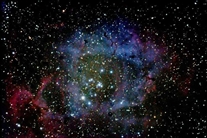 ngc2244-rosette-neb_40deg_140mmf070_20d-nr_3x480SecISO1600_Avg_ip-ddp2473-astrotools-sat-crv_ninja.jpg
The Rosette Nebula - (NGC 2244) and NGC 2237-9,46, Diffuse Nebula NGC 2237-9,46, Open Cluster NGC 2244 (= H VII.2), type 'c', in Monoceros
Rosette Nebula taken with TEC140mm f/7.0, canon 20d with in-camera noise reduction. 3x8mins at 1600 iso from backyard in bay area. Stacked with Images Plus 2.83, then processed in PhotoShop with astrotools, color saturation, curves, and Noise Ninja.
The Rosette Nebula - (NGC 2244) and NGC 2237-9,46, Diffuse Nebula NGC 2237-9,46, Open Cluster NGC 2244 (= H VII.2), type 'c', in Monoceros
Right Ascension 06 : 32.3 (h:m) 06 : 32.4 (h:m)
Declination +5 : 03 (deg:m) +4 : 52 (deg:m)
Distance 5.5 (kly) 5.5 (kly)
Visual Brightness ? (mag) 4.8 (mag)
Apparent Dimension 80x60 (arc min) 24 (arc min)
Discovered by John Flamsteed about 1690.
Excerpt from seds.org:
The Rosetta Nebula is a vast cloud of dust and gas, extending over an area of more than 1 degree across, or about 5 times the area covered by the full moon. Its parts have been assigned different NGC numbers: 2237, 2238, 2239, and 2246. Within the nebula, open star cluster NGC 2244 is situated, consisted of the young stars which recently formed from the nebula's material, and the brightest of which make the nebula shine by exciting its atoms to emit radiation. Star formation is still in progress in this vast cloud of interstellar matter; a recent finding of a very young star with a Herbig-Haro type jet by astronomers at the NOAO has been announced in Press Release NOAO 04-03 on January 22, 2004.
Although various values for its distance occur in the literature, our adopted distance from the Sky Catalog 2000 implies a true diameter of the nebula of about 130 light years. Burnham quotes a mass estimation of 10,000 (Minkowski 1949) to 11,000 (Menon 1962) solar masses, so it is one of the more massive diffuse nebulae.
Open cluster NGC 2244 was discovered by Flamsteed about 1690. The nebula, however, was not even seen by William Herschel (who found the cluster); its different parts were discovered only by John Herschel (NGC 2239 = GC 1420 = h 392), Marth (NGC 2238 = GC 5361 = Marth 99), and Swift (NGCs 2237 and 2246); note that while now these numbers are used for describing parts of the diffuse nebula, their original NGC description is quite different:
2237 pretty bright, very very large, diffuse (?= [GC] 5361 [= NGC 2238])
2238 small [faint] star in nebulosity
2239 star of mag 8 in large, poor, bright cluster
2246 extremely faint, large, irregularly round, extremely difficult
Nevertheless, the nebula is a splendid object, especially for astrophotography.
(ngc2244-rosette-neb_40deg_140mmf070_20d-nr_3x480SecISO1600_Avg_ip-ddp2473-astrotools-sat-crv.jpg)
b33-horsehead_ed80f075_20d-nr_3x20min_iso800_ip-flat-adpadd-ddp1649_pe-despeks1.jpg
b33-horsehead_ed80f075_20d-nr_3x20min_iso800_ip-flat-adpadd-ddp1649_pe-despeks1.jpg (b33-horsehead_ed80f075_20d-nr_3x20min_iso800_ip-flat-adpadd-ddp1649_pe-despeks1.jpg)
comet-73p_20d_k3_nr_180seciso3200_000002_ps-lvl-snr-dsnr-lpr-curve_pe-despkl.jpg
comet-73p_20d_k3_nr_180seciso3200_000002_ps-lvl-snr-dsnr-lpr-curve_pe-despkl.jpg (comet-73p_20d_k3_nr_180seciso3200_000002_ps-lvl-snr-dsnr-lpr-curve_pe-despkl.jpg)
comet-faye4p__ed80f075_20d-nr_300seciso1600_ip-ddp11416.jpg
comet-faye4p__ed80f075_20d-nr_300seciso1600_ip-ddp11416.jpg (comet-faye4p__ed80f075_20d-nr_300seciso1600_ip-ddp11416.jpg)
comet-machholz_q2_2004__adpadd23_dd_cropped.jpg
comet-machholz(q2 2004)_adpadd23_dd_cropped.jpg (comet-machholz(q2 2004)_adpadd23_dd_cropped.jpg)
comet-swan-m4_20d-nonr_8min_maxim.jpg
comet-swan-m4_20d-nonr_8min_maxim.jpg (comet-swan-m4_20d-nonr_8min_maxim.jpg)
comet-swan-m4_20d-nonr_maxim.jpg
comet-swan-m4_20d-nonr_maxim.jpg (comet-swan-m4_20d-nonr_maxim.jpg)
comet-tempel1_filesavg9.jpg
comet-tempel1_filesavg9.jpg (comet-tempel1_filesavg9.jpg)
comet-tempel10607051230_postimpact.jpg
comet-tempel10607051230_postimpact.jpg (comet-tempel10607051230_postimpact.jpg)
11/17/2007
Comet Holmes/17p
This comet exploded from a 17mag comet to about 3mag overnight. At mag 3, it was visible to the naked eye for several months and grew to a size larger than the sun. The change was discovered around October 22. My first images in the backyard were around Nov 5. In this highly processed image, you can clearly make out several jets streaming from the comet. What looks like the core of the comet is merely more dense gases surrounding the core.
This image is a single 30sec image at 1600 iso using a 28mm-300mm Sigma zoom lens at 300mm f/5.6 on a tripod with no tracking.
(IMG_0686.jpg)
11/17/2007
Comet Holmes/17p
(IMG_0694.jpg) holmes17-comet_735f480_20d50deg_241sec_IMG_0693_ps-crv-hipass-lvl-usm_ninja.jpg
holmes17-comet_735f480_20d50deg_241sec_IMG_0693_ps-crv-hipass-lvl-usm_ninja.jpg
11/17/2007
Comet Holmes/17p
This comet exploded from a 17mag comet to about 3mag overnight. At mag 3, it was visible to the naked eye for several months and grew to a size larger than the sun. The change was discovered around October 22. My first images in the backyard were around Nov 5. In this highly processed image, you can clearly make out several jets streaming from the comet. What looks like the core of the comet is merely more dense gases surrounding the core.
This was a single 241 second image using the 764mm f/4.8 Challenger scope and processed using photoshot hipass filtering.
(holmes17-comet_735f480_20d50deg_241sec_IMG_0693_ps-crv-hipass-lvl-usm_ninja.jpg)
coyote_hildebrandt_dsc00026.jpg
coyote_hildebrandt_dsc00026.jpg (coyote_hildebrandt_dsc00026.jpg)
A coyote we encounted on the way down from Nancy's place. Ground is frosty. We got within about 40 yards when it took off chasing after three female coyotes.
fpoaobservatoryfromfremontpeak_dsc00152.jpg
fpoaobservatoryfromfremontpeak_dsc00152.jpg (fpoaobservatoryfromfremontpeak_dsc00152.jpg)
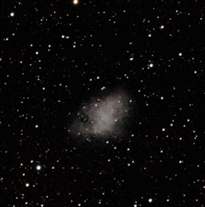 m001-crab_45deg_ed80f150_20d-nr_3x1200seciso800_ip-adpadd-ddp2960-crop.jpg
m001-crab_45deg_ed80f150_20d-nr_3x1200seciso800_ip-adpadd-ddp2960-crop.jpg (m001-crab_45deg_ed80f150_20d-nr_3x1200seciso800_ip-adpadd-ddp2960-crop.jpg)
M1 - Crab Nebula.
Image taken with Orion ED80 with 2" Orion Barlow and Canon 20D with internal nose reduction on. It is a stack of 3 images at 20mins each at 800 iso. Images Plus 2.83 adaptive add with DDP at 2960 and cropped to accentuate the nebula.
M1 is a supernova remnant, from a supernova in 1054 AD. Chinese history says that it was so bright that it cast a shadow. It was visible for a long time during the day and for months or years (I forget) at night. For the longest time, it was the brightest object in the sky. This is the first supernova within our galaxy that was recorded in history and witness by humans. The gas clouds continue to move away from the center at a rapid velocity. In addition, I believe the first pulsar was discovered in the center of the crab nebula using radio telescopes.
Messier 1
Supernova Remnant M1 (NGC 1952) in Taurus
Crab Nebula
Right Ascension 05 : 34.5 (h:m)
Declination +22 : 01 (deg:m)
Distance 6.3 (kly)
Visual Brightness 8.4 (mag)
Apparent Dimension 6x4 (arc min)
Discovered 1731 by British amateur astronomer John Bevis.
Excerpt from seds.org:
The Crab Nebula, Messier 1 (M1, NGC 1952), is the most famous and conspicuous known supernova remnant, the expanding cloud of gas created in the explosion of a star as supernova which was observed in the year 1054 AD. It shines as a nebula of magnitude 8.4 near the southern "horn" of Taurus, the Bull.
The supernova was noted on July 4, 1054 A.D. by Chinese astronomers as a new or "guest star," and was about four times brighter than Venus, or about mag -6. According to the records, it was visible in daylight for 23 days, and 653 days to the naked eye in the night sky. It was probably also recorded by Anasazi Indian artists (in present-day Arizona and New Mexico), as findings in Navaho Canyon and White Mesa (both Arizona) as well as in the Chaco Canyon National Park (New Mexico) indicate; there's a review of the research on the Chaco Canyon Anasazi art online. In addition, Ralph R. Robbins of the University of Texas has found Mimbres Indian art from New Mexico, possibly depicting the supernova.
The Supernova 1054 was also assigned the variable star designation CM Tauri. It is one of few historically observed supernovae in our Milky Way Galaxy.
The nebulous remnant was discovered by John Bevis in 1731, who added it to his sky atlas, Uranographia Britannica. Charles Messier independently found it on August 28, 1758, when he was looking for comet Halley on its first predicted return, and first thought it was a comet. Of course, he soon recognized that it had no apparent proper motion, and cataloged it on September 12, 1758. It was the discovery of this object which caused Charles Messier to begin with the compilation of his catalog. It was also the discovery of this object, which closely resembled a comet (1758 De la Nux, C/1758 K1) in his small refracting telescope, which brought him to the idea to search for comets with telescopes (see his note). Messier acknowledged the prior, original discovery by Bevis when he learned of it in a letter of June 10, 1771.
Although Messier's catalog was primarily compiled for preventing confusion of these objects with comets, M1 was again confused with comet Halley on the occasion of that comet's second predicted return in 1835.
This nebula was christened the "Crab Nebula" on the ground of a drawing made by Lord Rosse about 1844. Of the early observers, Messier, Bode and William Herschel correctly remarked that this nebula is not resolvable into stars, but William Herschel thought that it was a stellar system which should be resolvable by larger telescopes. John Herschel and Lord Rosse erroneously thought it is "barely resolvable" into stars. They and others, including Lassell in the 1850s, apparently mistook filamentary structures as indication for resolvability.
Early spectroscopic observations, e.g. by Winlock, revealed the gaseous nature of this object in the later 19th century. The first photo of M1 was obtained in 1892 with a 20-inch telescope. First serious investigations of its spectrum were performed in 1913-15 by Vesto M. Slipher (Slipher 1915, 1916): He found that the spectral emission lines were split. It was later recognised that the true reason for this is Doppler shift, as parts of the nebula are approaching us (thus their lines are blueshifted) and others receding from us (lines redshifted). In 1919, Roscoe Frank Sanford (Sanford 1919) found that the spectrum consists of two major contributions: First, a reddish component which forms a chaotic web of bright filaments, which has an emission line spectrum (including hydrogen lines) like that of diffuse gaseous (or planetary) nebulae, and second a strong blueish diffuse background which has a continuous spectrum.
Heber D. Curtis, in his description of this object based on Lick Observatory photographs, tentatively classified it as a planetary nebula (Curtis 1918), a view which was disproved only in 1933; this mis-classification can still be found in some much newer handbooks.
In 1921, C.O. Lampland of Lowell Observatory, when comparing excellent photographs of the nebula obtained with their 42-inch reflector, found notable motions and changes, also in brightness, of individual components of the nebula, including dramatic changes of some patches near the central pair of stars (Lampland 1921). The same year, J.C. Duncan of Mt. Wilson Observatory compared photographic plates taken 11.5 years apart, and found that the Crab Nebula was expanding at an average of about 0.2" per year; backtracing of this motion showed that this expansion must have begun about 900 years ago (Duncan 1921). Also the same year, Knut Lundmark noted the proximity of the nebula to the 1054 supernova (Lundmark 1921).
In 1942, based on investigations with the 100-inch Hooker telescope on Mt. Wilson, Walter Baade computed a more acurate figure of 760 years age from the expansion, which yields a starting date around 1180 (Baade 1942); later investigations improved this value to about 1140. The actual 1054 occurrance of the supernova shows that the expansion must have been accelerated.
The nebula consists of the material ejected in the supernova explosion, which has been spread over a volume approximately 10 light years in diameter, and is still expanding at the very high velocity of about 1,800 km/sec. The notion of gaseous filaments and a continuum background was photographically confirmed by Walter Baade and Rudolph Minkowski in 1930: The filaments are apparently the remnants from the former outer layers of the former star (the "pre-supernova" or supernova "progenitor"), while the inner, blueish nebula emits continuous light consisting of highly polarised so-called synchrotron radiation, which is emitted by high-energy (fast moving) electrons in a strong magnetic field. This explanation was first proposed by the Soviet astronomer J. Shklovsky (1953) and supported by observations of Jan H. Oort and T. Walraven (1956).
Synchrotron radiation is also apparent in other "explosive" processes in the cosmos, e.g. in the active core of the irregular galaxy M82 and the peculiar jet of giant elliptical galaxy M87. These striking properties of the Crab Nebula in the visible light are equally conspicuous in the Palomar images post-processed by David Malin of the Anglo Australian Observatory, and in Paul Scowen's image obtained on Mt. Palomar.
In 1949, the Crab nebula was identified as a strong source of radio radiation (Bolton et.al. 1949), discovered 1948 named and listed as Taurus A (Bolton 1948), and later as 3C 144. X-rays from this object were detected in April 1963 with a high-altitude rocket of type Aerobee with an X-ray detector developed at the Naval Research Laboratory; the X-ray source was named Taurus X-1. Measurements during lunar occultations of the Crab Nebula on July 5, 1964, and repeated in 1974 and 1975, demonstrated that the X-rays come from a region at least 2 arc minutes in size, and the energy emitted in X-rays by the Crab nebula is about 100 times more than that emitted in the visual light. Nevertheless, even the luminosity of the nebula in the visible light is enormous: At its distance of 6,300 light years (which is quite well-determined, by Virginia Trimble (1973)), its apparent brightness corresponds to an absolute magnitude of about -3.2, or more than 1000 solar luminosities. Its overall luminosity in all spectral ranges was estimated at 100,000 solar luminosities or 5*10^38 erg/s !
On November 9, 1968, a pulsating radio source, the Crab Pulsar (also cataloged as NP0532, "NP" for NRAO Pulsar, or PSR 0531+21), was detected in M1 by astronomers of the Arecibo Observatory 300-meter radio telescope in Puerto Rico. This star is the right (south-western) one of the pair visible near the center of the nebula in our photo. This pulsar was the first one which was also verified in the optical part of the spectrum, when W.J. Cocke, M.J. Disney and D.J. Taylor of Steward Observatory, Tucson, Arizona found it flashing at the same period of 33.085 milliseconds as the radio pulsar with the 90-cm (36-inch) telescope on Kitt peak; this discovery happened on January 15, 1969 at 9:30 pm local time (January 16, 1969, 3:30 UT, according to Simon Mitton). This optical pulsar is sometimes also referred to by the supernova's variable star designation, CM Tauri.
Only in 2007, it came to light that months before the detection of the Crab Pulsar - end even the first pulsar ever discovered - this object had been found in summer 1967, by US Air Force officer Charles Schisler on duty. Charles was on radar duty at Clear USAFB Alaska in summer 1967, when he noticed and logged a fluctuating radio source which was not moving, i.e. at fixed RA and Dec. The next day it was there again, and when he determined its position, he identified it with the Crab Nebula. Subsequently, he found a number of further pulsars. However, USAF decided that this was not their business, and didn't publish his findings. Therefore, Joycelyn Bell independently found her first pulsar a couple of months later.
It has now been established that this pulsar is a rapidly rotating neutron star: It rotates about 30 times per second! This period is very well investigated because the neutron star emits pulses in virtually every part of the electromagnetic spectrum, from a "hot spot" on its surface. The neutron star is an extremely dense object, denser than an atomic nucleus, concentrating more than one solar mass in a volume of 30 kilometers across. Its rotation is slowly decelerating by magnetic interaction with the nebula; this is now a major energy source which makes the nebula shining; as stated above, this energy source is 100,000 times more energetic than our sun.
In the visible light, the pulsar is of 16th apparent magnitude. This means that this very small star is roughly of absolute magnitude +4.5, or about the same luminosity as our sun in the visible part of the spectrum !
Jeff Hester and Paul Scowen have used the Hubble Space Telescope to investigate the Crab Nebula M1 (see also e.g. Sky & Telescope of January, 1995, p. 40). Their continuous investigations with the HST have provided new insight into the dynamic and changes of the Crab nebula and pulsar. More recently, the Heart of the Crab was investigated by HST astronomers.
This object has attracted so much interest that it was remarked that astronomers can be devided into two fractions of about same size: Those who do work related to the Crab nebula, and those who don't. There was a "Crab Nebula Symposium" in Flagstaff, Arizona in June, 1969 (see PASP Vol. 82, May 1970 for results - Burnham). The IAU symposium No. 46, held at Jodrell Bank (England) in August 1970 was solely devoted to this object. Simon Mitton has written a nice book on the Crab Nebula M1 in 1978, which is still most readable and informative (it is also source for some of the informations here).
The Crab Nebula can be found quite easily from Zeta Tauri (or 123 Tauri), the "Southern Horn" of the Bull, a 3rd-magnitude star which can be easily found ENE of Aldebaran (Alpha Tauri). M1 is about 1 deg N and 1 deg W of Zeta, just slightly south and about 1/2 degree west of a mag-6 star, Struve 742.
The nebula can be easily seen under clear dark skies, but can equally easily get lost in the background illumination under less favorable conditions. M1 is just visible as a dim patch in 7x50 or 10x50 binoculars. With a little more magnification, it is seen as a nebulous oval patch, surrounded by haze. In telescopes starting with 4-inch aperture, some detail in its shape becomes apparent, with some suggestion of mottled or streak structure in the inner part of the nebula; John Mallas reports that under excellent conditions, an experienced observer can see them throughout the inner portion of the nebula. The amateur can verify Messier's impression that M1 looks indeed similar to a faint comet without tail in smaller instruments. Only under excellent conditions and with larger telescopes, starting at about 16 inches aperture, suggestions of the filaments and fine structure may become visible.
As the Crab Nebula is situated only 1 1/2 degrees from the ecliptic, there are frequent conjunctions and occasional transits of planets, as well as occultations by the Moon (some of them mentioned above).
M1 is situated in a nice Milky Way field. The star Zeta Tauri is remarkable as it is a Gamma Cassiopeiae type variable, a rather rapidly rotating star of spectral type B4 III pe which has ejected an expanding gas shell, and has a fainter spectroscopic companion star in an orbit of about 133 days period. Preceding M1 two minutes (or half a degree) in Right Ascension is Struve 742 or ADS 4200, another visual binary star with components A (mag 7.2, spectrum F8, of yellow color) and B (mag 7.8, white) separated by about 3.6" in position angle 272deg, and orbiting each other in about 3000 years.
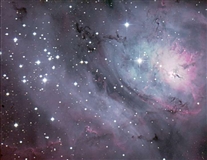 m008_lagoon_avg_200percent_ps-um-lvl.jpg
m008_lagoon_avg_200percent_ps-um-lvl.jpg (m008_lagoon_avg_200percent_ps-um-lvl.jpg)
M8 - The Lagoon Nebula.
This is right near the heart of the Milky Way from our vantage point in Sagatarius. It is actually a naked eye object. This image was taken with the 30" f/4.8 Challenger observatory scope at Fremont Peak and Canon 20D.
Messier 8
Starforming Nebula M8 (NGC 6523), an emission nebula, with open star cluster, type "e", in Sagittarius
Lagoon Nebula
Right Ascension 18 : 03.8 (h:m)
Declination -24 : 23 (deg:m)
Distance 5.2 (kly)
Visual Brightness 6.0 (mag)
Apparent Dimension 90x40 (arc min)
Discovered by Hodierna about 1654.
Excerpt from seds.org:
The Lagoon Nebula Messier 8 (M8, NGC 6523) is one of the finest and brightest star-forming regions in the sky. It is a giant cloud of interstellar matter which is currently undergoing vivid star formation, and has already formed a considerable cluster of young stars.
This object has been discovered by Giovanni Battista Hodierna before 1654, and classified it as "nebulosa," i.e. of intermediate brightness; it is his No. II.6. It was independently noted as a "nebula" by John Flamsteed about 1680, who cataloged it as his No. 2446. Due to reasons which are not completely clear, at least to the present author [hf], Kenneth Glyn Jones has supposed that Flamsteed may only have seen the cluster within this nebula, a view which we had formerly adopted here. However, Flamsteed's position is close to that later determined by Messier and near the center of the nebula, while the young open cluster, which was later cataloged as NGC 6530, is situated (or at least centered) in the Eastern half of M8.
This object was again seen by Philippe Loys de Chéseaux in 1746, who could resolve some stars and consequently classified it as a cluster. One year later, in 1747, it was observed by Guillaume Le Gentil, who found the nebula together with the cluster. Abbe Nicholas Louis de la Caille has cataloged it in his 1751-52 compilation as Lacaille III.14. When Charles Messier cataloged this object on May 23, 1764, he primarily described the cluster, and mentioned the nebula separately as surrounding the star 9 Sagittarii; his original position is closer to the modern position of the cluster than to that of the nebula. Nevertheless, until recently, most sources identified only the nebula with "Messier 8," a view we reject here: It is clear from Messier's description that he had found both the nebula and the cluster.
William Herschel assigned separate catalog numbers to two objects within, or parts of, the Lagoon Nebula: H V.9 (GC 4363, NGC 6526) and H V.13 (GC 4368, NGC 6533) which are described as large and faint nebulae in the NGC. John Herschel eventually cataloged the open cluster NGC 6530 separately as h 3725 (GC 4366); he has M8 as h 3723 (GC 4361, NGC 6523).
According to Kenneth Glyn Jones, the Lagoon Nebula has an apparent extension of 90x40 minutes of arc, which is 3 x 1 1/3 the apparent diameter of the full moon, and corresponds to about 140x60 light years if our distance of 5,200 light years should be correct, which is a bit uncertain; newer sources have 4850 (Glyn Jones) to 6500, but David J. Eichler gives the value of 5,200 light years (Eichler 1996).
One of the remarkable features of the Lagoon Nebula is the presence of dark nebulae known as 'globules' (Burnham) [see expanded image] which are collapsing protostellar clouds with diameters of about 10,000 AU (Astronomical Units). They can also be seen, along with other detail, in the DSSM image of M8. Some of the more conspicuous globules have been cataloged in E.E. Barnard's catalog of dark nebulae: Barnard 88 (B 88), the comet-shaped globule extended North-to-South (up-down) in the left half and near top of our image, small B 89 in the region of cluster NGC 6530, and long, narrow black B 296 at the south edge of the nebula (lower edge of the image). According to David Eichler, the nebula has probably a depth comparable to its linear extension indicated above.
Within the brightest part of the Lagoon Nebula, a remarkable feature can be seen, which according to its shape is called the "Hourglass Nebula" (see our detailed photos). This feature was discovered by John Herschel and occurs in a region where a vivid star formation process appears to take place currently; the bright emission is caused by heavy excitation of very hot, young stars, the illuminator of the hourglass is the hot star Herschel 36 (mag 9.5, spectral class O7). Closely by this feature is the apparently brightest of the stars associated with the Lagoon Nebula, 9 Sagittarii (mag 5.97, spectral class O5), which surely contributes a lot of the high energy radiation which excites the nebula to shine.
As published in January 1997, the Hubble Space Telescope has been used to study the Hourglass Nebula region in the Lagoon Nebula M8.
The Lagoon Nebula is a magnificient object for the amateur astrophotographer, as Brad Wallis and Robert Provin have demonstrated with their outstanding images, and Dr. Andjelko Glivar with his photos taken through a Celestron 8.
The young open cluster NGC 6530 associated with the Lagoon Nebula M8 was classified as of Trumpler type "II 2 m n" (see e.g. the Sky Catalog 2000), meaning that it is detached but only weakly concentrated toward its center, its stars scatter in a moderate range of brightness, it is moderately rich (50--100 stars), and associated with nebulosity (certainly, with the Lagoon nebula). As the light of its member stars show little reddening by interstellar matter, this cluster is probably situated just in front of the Lagoon Nebula. Its brightest star is a 6.9 mag hot O5 star, and Eichler gives its age as 2 million years. Woldemar Götz mentions this cluster as containing one peculiar Of star, an extremely hot bright star of spectral type O with peculiar spectral lines of ionized Helium and Nitrogen.
The nebula's faint extension to the East (top in our image, but beyond) has an own IC number: IC 4678.
M8 is situated in a very conspicuous field of the Sagittarius Milky Way. Another capture from the DSSM shows the Lagoon Nebula M8 and Trifid Nebula M20, plus the rich star field and faint nebulae surrounding them. We have also more images of the region of M8 and M20, which sometimes also include the nearby open star cluster M21.
m013_127mmf121_20d-nr_300seciso1600_000002_ip-ddp4122-statdiff1515-addbal_5299-6189_0922.jpg
m013_127mmf121_20d-nr_300seciso1600_000002_ip-ddp4122-statdiff1515-addbal+5299-6189+0922.jpg (m013_127mmf121_20d-nr_300seciso1600_000002_ip-ddp4122-statdiff1515-addbal+5299-6189+0922.jpg)
M13 - Hercules Cluster. A single 5min exposure with in-cam noise reduction at 1600 iso from backyard in the bay area. The scope was a friend's 127mm f/12.1 Orion MakCas. Nice little scope. The seeing was exceptionaly that night. 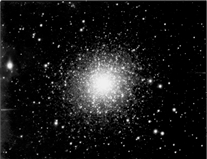 M013_DSI2PRO_09C_CLEAR_13x300sec_ip-adpadd.jpg
M013_DSI2PRO+09C_CLEAR_13x300sec_ip-adpadd.jpg Enter image description for image (M013_DSI2PRO+09C_CLEAR_13x300sec_ip-adpadd.jpg)
M13 taken with DSI2 and 10" f/10 Meade classic OTA on AP1200 mount. 9C sensor temp on DSI 2 Pro
13x5min exposures.
Note small galaxy at the top.
M13 is call the Hercules Cluster because it is in the constellation Hercules. It is very large and it can be seen with binoculars as a fuzzy object.
Messier 13
Globular Cluster M13 (NGC 6205), class V, in Hercules
Hercules Globular Cluster
Right Ascension 16 : 41.7 (h:m)
Declination +36 : 28 (deg:m)
Distance 25.1 (kly)
Visual Brightness 5.8 (mag)
Apparent Dimension 20.0 (arc min)
Discovered by Edmond Halley in 1714.
Excerpt from seds.org:
Messier 13 (M13, NGC 6205), also called the 'Great globular cluster in Hercules', is one of the most prominent and best known globulars of the Northern celestial hemisphere.
It was discovered by Edmond Halley in 1714, who noted that 'it shows itself to the naked eye when the sky is serene and the Moon absent.' According to Charles Messier, who cataloged it on June 1, 1764, it is also reported in John Bevis' "English" Celestial Atlas.
At its distance of 25,100 light years, its angular diameter of 20' corresponds to a linear 145 light years - visually, it is perhaps 13' large. It contains several 100,000 stars; Timothy Ferris in his book Galaxies even says "more than a million". Towards its center, stars are about 500 times more concentrated than in the solar neighborhood. The age of M13 has been determined by Sandage as 24 billion years and by Arp as 17 billion years around 1960; Arp later (in 1962) revised his value to 14 billion years (taken from Kenneth Glyn Jones).
According to Kenneth Glyn Jones, M13 is peculiar in containing one young blue star, Barnard No. 29, of spectral type B2. The membership of this star was confirmed by radial velocity measurement, and is strange for such an old cluster - apparently it is a captured field star.
Observers note 4 apparently star-poor regions in M13 (e.g., Mallas). Suggestions of them can be noted in some photos.
Globular cluster M13 was selected in 1974 as target for one of the first radio messages addressed to possible extra-terrestrial intelligent races, and sent by the big radio telescope of the Arecibo Observatory.
Nearby, about 40 arc minutes north-east of M13, is the faint (mag 11) galaxy NGC 6207, visible in many large- and medium-size-field photographs of M13, e.g., in the DSSM image. This galaxy has recently produced a type II supernova (SN 2004A).
 m016_adpadd26_ps_umask.jpg
m016_adpadd26_ps_umask.jpg (m016_adpadd26_ps_umask.jpg)
M16 - Eagle Nebula and the Pinnacles of Life
This was an elusive target for me. I could never really get the pinnacles with the resulution I should have with the 12" SCT. This image was a stack of 26 3min stops at 1600 iso taken at Fremont Peak.
Messier 16
Starforming Nebula M16 (IC 4703, NGC 6611), an emission nebula, with Open Star Cluster, type 'e', in Serpens (Cauda)
Eagle Nebula
Right Ascension 18 : 18.8 (h:m)
Declination -13 : 47 (deg:m)
Distance 7.0 (kly)
Visual Brightness 6.4 (mag)
Apparent Dimension 7.0 (arc min)
Excerpt from seds.org:
Cluster M16 (NGC 6611) discovered by Philippe Loys de Chéseaux in 1745-6.
Nebula M16 (IC 4703) discovered by Charles Messier in 1764.
The Eagle Nebula Messier 16 (M16) is a conspicuous region of active star formation, situated in Serpens Cauda. The starforming nebula, a giant cloud of interstellar gas and dust, has already created a considerable cluster of young stars. The cluster is also referred to as NGC 6611, the nebula as IC 4703.
The discoverer, Philippe Loys de Chéseaux, describes only the cluster when recording his 1745-1746 discovery. Charles Messier, on his independent rediscovery of June 3, 1764, mentions that these stars appeared "enmeshed in a faint glow", probably suggestions of the nebula. The Herschels apparently didn't perceive the nebula, so that their catalogs and consequently, the NGC, only describe the cluster. The nebula was added in the IC II of 1908 as IC 4703, with "cluster M16 involved", but the NGC 2000.0 erroneously classifies this object as an open cluster.
The nebula was probably first photographed by E.E. Barnard in 1895, and by Isaac Roberts in 1897; Isaac Robert's finding brought this object into the IC catalog.
Lying some 7,000 light years distant in the constellation Serpens, close to the borders to Scutum and Sagittarius, and in the next inner spiral arm of the Milky Way galaxy from us (the Sagittarius or Sagittarius-Carina Arm) a great cloud of interstellar gas and dust has entered a vivid process of star formation. Open star cluster M16 has formed from this great gaseous and dusty cloud, the diffuse Eagle Nebula IC 4703, which is now caused to shine by emission light, excited by the high-energy radiation of its massive hot, young stars. It is actually still in the process of forming new stars, this formation taking place near the dark "elephant trunks" which are well visible in our photograph, as well as in AAT pictures and other images of M16. A deeper insight in the star formation process could be obtained from the HST images of M16, published in November 1995; moreover, they were used for an animation simulating the approach to this star forming region, and we provide some screen sized images (suitable as backgrounds for your computer screen).
This stellar swarm is only about 5.5 million years old (according to the Sky Catalog 2000 and Götz) with star formation still active in the Eagle Nebula; this results in the presence of very hot young stars of spectral type O6. The cluster was classified as of Trumpler type II,3,m,n (Götz). The brightest star of M16 is of visual magnitude 8.24. At its distance of 7,000 light years, its angular diameter of 7 arc minutes corresponds to a linear extension of about 15 light years. The nebula extends much farther out, to a diameter of over 30', corresponding to a linear size of about 70x55 light years.
Some sources have smaller distances for M16: Kenneth Glyn Jones gives 5,870. Götz 5,540 light years. Götz states that this is one of the intrinsically most luminous open clusters, at an absolute magnitude of -8.21.
M16 is found rather easily, either by locating the star Gamma Scuti, a white giant star of magnitude 4.70 and spectral type A2 III, e.g. from Altair (Alpha Aquilae) via Delta and Lambda Aql; M16 is about 2 1/2 deg (19 min in RA) west of this star. Or, in particular with a pair of binoculars, locate star cloud M24, and move northward via a pair of stars of 6th and 7th mag, followed by small open cluster M18 1deg North of M24, the magnificient Omega Nebula M17 another 1deg N, and finally another 2deg N, M16.
Star cluster M16 and the Eagle Nebula are best seen with low powers in telescopes. A 4-inch reveals about 20 stars in an uneven background of fainter stars and nebulosity; three nebulous concentrations can be glimpsed under good observing conditions. Under very good conditions, suggestions of dark obscuring matter can be seen to the north of the cluster. The Eagle nebula is best seen on photographs, but larger apertures and nebula filters (O-III) may help to trace some detail visually. The dark pillars can be seen in large amateur instruments (12-inch up).
m020_trifidnebulain3d.jpg
m020_trifidnebulain3d.jpg (m020_trifidnebulain3d.jpg)
If you stare at this image, you get a false sense of 3D. Some stars seem to be up front and some farther away. It is a cheesy experiment but kind of fun in the process. 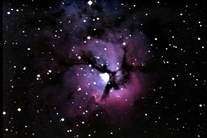 (m020avg4_ps2.c.jpg)
M20 - Trifid Nebula
Image taken with 764mm (30") f/4.8 FPOA Challenger observatory scope.
The Trifid Nebula gets its name from the three main "petals" in this flower shaped nebula. There are actually four such petals, but only three were visible when it got its name, hense the "tri" part of its name. This nebula has lots of blue reflection nebula component to it, where as the nearby M8 Lagoon Nebula is different.
Messier 20
Starforming Nebula M20 (NGC 6514), an emission and reflection nebula, with Open Star Cluster, in Sagittarius
Trifid Nebula
Right Ascension 18 : 02.6 (h:m)
Declination -23 : 02 (deg:m)
Distance 5.2 (kly)
Visual Brightness 9.0 (mag)
Apparent Dimension 28.0 (arc min)
Discovered by Charles Messier in 1764.
Excerpt from seds.org:
The Trifid Nebula Messier 20 (M20, NGC 6514) in Sagittarius is a remarkable and beautiful object as it consists of both a conspicuous emission nebula and a remarkable reflection nebula component.
Charles Messier discovered this object on June 5, 1764, and described it as a cluster of stars of 8th to 9th magnitude, enveloped in nebulosity, where the remark on nebulosity follows only after the description of nearby M21, and includes that object.
The Trifid Nebula M20 is famous for its three-lobed appearance. This may have caused William Herschel, who normally carefully avoided to number Messier's objects in his catalog, to assign four different numbers to parts of this nebula: H IV.41 (cataloged May 26, 1786) and H V.10, H V.11, H V.12 (dated July 12, 1784). That he numbered this object at all may have its reason in the fact that Messier merely described it as 'Cluster of Stars.' The name 'Trifid' was first used by John Herschel to describe this nebula; this astronomer assigned only one catalog entry to the whole object (h 1991, h 3718, GC 4355) which became J.L.E. Dreyer's NGC 6514.
The dark nebula, which is the reason for the Trifid's appearance, was cataloged by Barnard as Barnard 85 (B 85).
The red emission nebula with its young star cluster near its center is surrounded by a blue reflection nebula which is particularly conspicuous to the northern end. The nebula's distance is rather uncertain, with values between 2,200 light years (Mallas/Kreimer; Glyn Jones has 2,300) and about 7,600 light years (C.R. O'Dell 1963). The Sky Catalog 2000 gives 5,200 light years, a value which is also used by Archinal and Hynes (2003), and which we adopt here. The WEBDA database has 3140, the Hubble Press Release of Jeff Hester (STScI-PRC99-42) gives "about 9000" light years.
As often for nebulae, magnitude estimates spread widely: Kenneth Glyn Jones gives 9.0, while Machholz has estimated 6.8 mag. This may partly come from the fact that the exciting star, HD 196692 or HN 40 or ADS 10991, is a triple system of 7th integrated magnitude (with components A: 7.6, B: 10.7, C: 8.7 mag). All are extremely hot; component A is of spectral type O5 to O7. The Sky Catalogue 2000.0 even lists 4 more, faint components of this "multiple star:" D: 10.7, E: 12.6, F: 14.0, and G: 13.4 mag. This star is located on the west side of the Trifid Nebula cluster. Situated on the northern edge is HD 164514 of visual magnitude 7.42, a supergiant of spectral type A5 Ia. The presence of these considerably bright stars makes brightness estimates for the nebula difficult.
In the sky, the Trifid nebula M20 is situated roughly 2 degrees northwest of the larger Lagoon Nebula M8, so that both nebulae form a nice target for wide field photographs, as these images of the M8 and M20 region, or the big DSSM image of this region. It is even closer to the open cluster M21 and shows up in the upper left edge of our M21 image.
m027_ed80f075_20d-nr_60seciso1600_ip-ddp11416.jpg
m027_ed80f075_20d-nr_60seciso1600_ip-ddp11416.jpg (m027_ed80f075_20d-nr_60seciso1600_ip-ddp11416.jpg)
M27 - Dumbell Nebula
Orion ED80 f/7.5 with Canon 20D - incamera noise reduction. Single 60sec exposure at 1600iso.
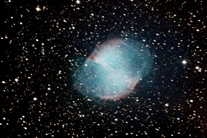 m027dumbellnebadpadd27_ip-ddh.cropped1024.jpg
m027dumbellnebadpadd27_ip-ddh.cropped1024.jpg (m027dumbellnebadpadd27_ip-ddh.cropped1024.jpg)
M27 - Dumbell Nebula
This was taken with the 764mm f/4.8 Challenger observatory scope. It is a stack of 27 images at about 1-2min each.
Messier 27
Planetary Nebula M27 (NGC 6853), type 3a+2, in Vulpecula
Dumbbell Nebula
Right Ascension 19 : 59.6 (h:m)
Declination +22 : 43 (deg:m)
Distance 1.25 (kly)
Visual Brightness 7.4 (mag)
Apparent Dimension 8.0x5.7 (arc min)
Discovered by Charles Messier in 1764.
Excerpt from seds.org:
The Dumbbell Nebula Messier 27 (M27, NGC 6853) is perhaps the finest planetary nebula in the sky, and was the first planetary nebula ever discovered.
On July 12, 1764, Charles Messier discovered this new and fascinating class of objects, and describes this one as an oval nebula without stars. The name "Dumb-bell" goes back to the description by John Herschel, who also compared it to a "double-headed shot."
We happen to see this one approximately from its equatorial plane (approx. left-to-right in our image); this is similar to our view of another, fainter Messier planetary nebula, M76, which is called the Little Dumbbell. From near one pole, it would probably have the shape of a ring, and perhaps look like we view the Ring Nebula M57.
This planetary nebula is certainly the most impressive object of its kind in the sky, as the angular diameter of the luminous body is nearly 6 arc minutes, with a faint halo extensing out to over 15', half the apparent diameter of the Moon (Millikan 1974). It is also among the brightest, being at most little less luminous with its estimated apparent visual magnitude 7.4 than the brightest, the Helix Nebula NGC 7293 in Aquarius, with 7.3, which however has a much lower surface brightness because of its larger extension (estimates from Stephen Hynes); it is a bit unusual that this planetary is only little fainter photographically (mag 7.6). The present author (hf) was surprized how fine this object was seen in his 10x50 binoculars under moderately good conditions !
As measured by Soviet astronomer O.N. Chudowitchera from Pulkowo (and mentioned by L.H. Aller, Glyn Jones and Vehrenberg), the bright portion of the nebula is apparently expanding at a rate of 6.8 arc seconds per century, leading to an estimated age of 3,000 to 4,000 years, i.e. the shell ejection probably would have been observable this time ago (it actually happened earlier as the light had to travel all the distance of perhaps about 1000 light years). She estimated the distance somewhat short at only about 490 ly. Another estimate, given by Burnham, has obtained a rate 1.0 arc seconds per century, and an estimated age of 48,000 years.
The central star of M27 is quite bright at mag 13.5, and an extremely hot blueish subdwarf dwarf at about 85,000 K (so the spectral type is given as O7 in the Sky Catalog 2000). K.M. Cudworth of the Yerkes Observatory found that it probably has a faint (mag 17) yellow companion at 6.5" in position angle 214 deg (Burnham).
As for most planetary nebulae, the distance of M27 (and thus true dimension and intrinsic luminosity) is not very well known. Hynes gives about 800, Kenneth Glyn Jones 975, Mallas/Kreimer 1250 light years, while other existing estimates reach from 490 to 3500 light years. Currently, investigations with the Hubble Space Telescope are under work to determine a more reliable and acurate value for the distance of the Dumbbell Nebula.
Adopting our value of 1200 light years, the intrinsic luminosity of the gaseous nebula is about 100 times that of the Sun (about -0.5 Mag absolute) while the star is at about +6 (1/3 of the Sun) and the companion at +9..9.5 (nearly 100 times fainter than the Sun), all in the visual light part of the electromagnetic spectrum. That the nebula is so much brighter than the star shows that the star emits primarily highly energetic radiation of the non-visible part of the electro-magnetic spectrum, which is absorbed by exciting the nebula's gas, and re-emitted by the nebula, at last to a good part in the visible light. Actually, as for almost all planetary nebulae, most of the visible light is even emitted in one spectral line only, in the green light at 5007 Angstrom (see our planetary nebula description) !
By comparing images of the Dumbbell Nebula M27, Leos Ondra has discovered a variable star situated in the very outskirts of the nebula which he called Goldilocks' Variable. This variable can be found in some of our images, namely those of Jack Newton, Peter Sütterlin and (faintly) David Malin's INT photo, as well as one of the images by John Sefick. Other images such as the one in this page don't show this star, proving its variability.
About 2deg to the West of M27 is inconspicuous open cluster NGC 6830, containing about 20-30 widely scattered stars; this cluster is about 5500 ly distant.
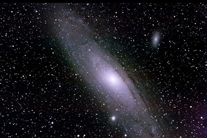 m031_57deg_ed80f075_20d_800iso_10x300sec_sigmed_ps-lvl-curve-usm.jpg
m031_57deg_ed80f075_20d_800iso_10x300sec_sigmed_ps-lvl-curve-usm.jpg (m031_57deg_ed80f075_20d_800iso_10x300sec_sigmed_ps-lvl-curve-usm.jpg)
M31 - The Great Andromeda Galaxy. M32 and M110 are also visible in this image.
Orion ED80 f/7.5, canon 20D, 800 iso. 10 x 5min exposures stacked in Images Plus 2.83. Prettied up in photoshop.
M31 is about 2.4 million light years away and it is the most distant object viewable with the naked eye. Our Milky Way galaxy is falling toward M31 at nearly 1 million miles per hour.
Messier 31
Spiral Galaxy M31 (NGC 224), type Sb, in Andromeda
Andromeda Galaxy
Right Ascension 00 : 42.7 (h:m)
Declination +41 : 16 (deg:m)
Distance 2900 (kly)
Visual Brightness 3.4 (mag)
Apparent Dimension 178x63 (arc min)
Known to Al-Sufi about AD 905.
Excerpt from seds.org:
Messier 31 (M31, NGC 224) is the famous Andromeda galaxy, our nearest large neighbor galaxy, forming the Local Group of galaxies together with its companions (including M32 and M110, two bright dwarf elliptical galaxies), our Milky Way and its companions, M33, and others.
Visible to the naked eye even under moderate conditions, this object was known as the "little cloud" to the Persian astronomer Abd-al-Rahman Al-Sufi, who described and depicted it in 964 AD in his Book of Fixed Stars: It must have been observed by and commonly known to Persian astronomers at Isfahan as early as 905 AD, or earlier. R.H. Allen (1899/1963) reports that it was also appeared on a Dutch starmap of 1500. Charles Messier, who cataloged it on August 3, 1764, was obviously unaware of this early reports, and ascribed its discovery to Simon Marius, who was the first to give a telescopic description in 1612, but (according to R.H. Allen) didn't claim its discovery. Unaware of both Al Sufi's and Marius' discovery, Giovanni Batista Hodierna independently rediscovered this object before 1654. Edmond Halley, however, in his 1716 treat of "Nebulae", accounts the discovery of this "nebula" to the French astronomer Bullialdus (Ismail Bouillaud), who observed it in 1661; but Bullialdus mentions that it had been seen 150 years earlier (in the early 1500s) by some anonymous astronomer (R.H. Allen, 1899/1963).
It was longly believed that the "Great Andromeda Nebula" was one of the nearest nebulae. William Herschel believed, wrongly of course, that its distance would "not exceed 2000 times the distance of Sirius" (17,000 light years); nevertheless, he viewed it at the nearest "island universe" like our Milky Way which he assumed to be a disk of 850 times the distance of Sirius in diameter, and of a thickness of 155 times that distance.
It was William Huggins, the pioneer of spectroscopy, who noted in 1864 the difference between gaseous nebula with their line spectra and those "nebulae" with star-like, continuous spectra, which we now know as galaxies, and found a continuous spectrum for M31 (Huggins and Miller 1864).
In 1887, Isaac Roberts obtained the first photographs of the Andromeda "Nebula," which showed the basic features of its spiral structure for the first time.
In 1912, V.M. Slipher of Lowell Observatory measured the radial velocity of the Andromeda "nebula" and found it the highest velocity ever measured, about 300 km/sec in approach. This already pointed to the extra-galactic nature of this object. According to Burnham, a better value is about 266 km/sec, but R. Brent Tully gives 298 km/sec, and NED has again 300 +/- 4 km/s as the modern value. Note that all the previous values describe the motion with respect to our Solar System, i.e. heliocentric motion, not that w.r.t. the Milky Way's Galactic Center. The latter value can be obtained by correcting for the motion of our Solar System around that center. The modern values for Galactic rotation and heliocentric radial velocity yield that the Andromeda Galaxy and the Milky Way are approaching each other at about 100 km/sec.
In 1923, Edwin Hubble found the first Cepheid variable in the Andromeda galaxy and thus established the intergalactic distance and the true nature of M31 as a galaxy. Because he was not aware of the two Cepheid classes, his distance was incorrect by a factor of more than two, though. This error was not discovered until 1953, when the 200-inch Palomar telescope was completed and had started observing. Hubble published his epochal study of the Andromeda "nebula" as an extragalactic stellar system (galaxy) in 1929 (Hubble 1929).
At modern times, the Andromeda galaxy is certainly the most studied "external" galaxy. It is of particular interest because it allows studies of all the features of a galaxy from outside which we also find in Milky Way, but cannot observe as the greatest part of our Galaxy is hidden by interstellar dust. Thus there are continuous studies of the spiral structure, globular and open clusters, interstellar matter, planetary nebulae, supernova remnants (see e.g. Jeff Kanipe's article in Astronomy, November 1995, p. 46), galactic nucleus, companion galaxies, and more.
Some of the features mentioned above are also of interest for the amateur: Even Charles Messier found its two brightest companions, M32 and M110 which are visible in binoculars and conspicuous in small telescopes, and created a drawing of all three. These two relatively bright and relatively close companions are visible in many photos of M31, including the one in this page. They are only the brightest of a "swarm" of smaller companions which surround the Andromeda Galaxy, and form a subgroup of the Local Group. At the time of this writing (September 2003), at least 11 of them are known: Besides M32 and M110 these are NGC 185, which was discovered by William Herschel, and NGC 147 (discovered by d'Arrest) as well as the very faint dwarf systems And I, And II, And III, possibly And IV (which may however be a cluster or a remote background galaxy), And V, And VI (also called the Pegasus dwarf), And VII (also Cassiopeia dwarf), and And VIII. It is still not clear if M33, the smaller spiral galaxy in Triangulum, and its probable companion LGS 3 belong to this subgroup, or the more remote Local Group member IC 1613, or one of the possible member candidates UGCA 86 or UGCA 92.
The Andromeda Galaxy is in notable interaction with its companion M32, which is apparently responsible for a considerable amount of disturbance in the spiral structure of M31. The arms of neutral hydrogen are displaced from those consisted of stars by 4000 light years, and cannot be continuously followed in the area closest to its smaller neighbor. Computer simulations have shown that the disturbances can be modelled by a recent close encounter with a small companion of the mass of M32. Very probably, M32 has also suffered from this encounter by losing many stars which are now spread in Andromeda's halo.
The brightest globular cluster of the Andromeda Galaxy M31, G1, is also the most luminous globular in the Local Group of Galaxies; its apparent visual brightness from Earth is still about 13.72 magnitudes. It outshines even the brightest globular in our Milky Way, Omega Centauri, and can be glimpsed even by better equipped amateurs under very favorable conditions, with telescopes starting at 10-inch aperture (see Leos Ondra's article in Sky & Telescope, November 1995, p. 68-69). The Hubble Space Telescope was used to investigate globular cluster G1 in mid-1994 (published April 1996). While the easiest, G1 is not the only M31 globular cluster which is in the reach of large amateur telescopes: Amateur Steve Gottlieb has observed 18 globular clusters of M31 with a 44cm telescope. With their 14-inch Newton and CB245 CCD camera, observers of the Ferguson Observatory near Kenwood, CA have photographed G1 and four fainter M31 globulars. Barmby et.al (2000) have found 435 globular cluster candidates in M31, and estimate the total number at 450 +/- 100.
The astrophotographer is even better off, as he can gather the fainter light of the fine detail in the spiral arms, as in our image: Amateurs can obtain most striking pictures even with inexpensive equipment, from wide-field exposures to detailed close-ups. Also in photography, better equipment pays off, as is demonstrated by our image, which was obtained by (and is courtesy of) Texas amateur Jason Ware, with a 6-inch refractor. More information on this image is available.
The brightest star cloud in the Andromeda galaxy M31 has been assigned an own NGC number: NGC 206, because William Herschel had taken it into his catalog as H V.36 on the grounds of his discovery observation of October 17, 1786. It is the bright star cloud at the upper left, just below a conspicuous dark nebula, in our photograph (very conspicuous in the larger photo).
Despite the large amount of knowledge we now have about the Andromeda Galaxy, its distance, though among the best known intergalactic distances, is not really well-known. While it is well established that M31 is about 15-16 times further away than the Large Magellanic Cloud (LMC), the absolute value of this measure is still uncertain, and in current sources, usually given between 2.4 and 2.9 million light-years - a consequence of the uncertainty in the LMC distance and thus the overall intergalactic distance scale. E.g., the semi-recent correction from data by ESA's astrometrical satellite Hipparcos has pushed this value up by more than 10 percent, from about 2.4-2.5 to the about 2.9 million light-years we use here.
Under "normal" viewing conditions, the apparent size of the visible Andromeda Galaxy is about 3 x 1 degrees (our acurate value, given above, is 178x63 arc minutes, while NED gives 190x60'). Careful estimates of its angular diameter, performed with 2-inch binoculars, by the French astronomer Robert Jonckhere in 1952-1953, revealed an extension of 5.2 times 1.1 degrees (reported by Mallas), corresponding to a disk diameter of over 250,000 light years at its distance of 2.9 million light years, so that this galaxy is more than double as large as our own Milky Way galaxy ! Its mass was estimated at 300 to 400 billion times that of the sun. Compared to the newer estimates for our Milky Way galaxy, this is considerably less than the mass of our galaxy, implying that the Milky Way may be much denser than M31. These results are confirmed by new estimates of the total halo masses, which turn out to be about 1.23 trillion solar masses for M31, compared to 1.9 trillion for the Milky Way (Evans and Wilkinson, 2000).
The Hubble Space Telescope has revealed that the Andromeda galaxy M31 has a double nucleus. This suggests that either it has actually two bright nuclei, probably because it has "eaten" a smaller galaxy which once intruded its core, or parts of its only one core are obscured by dark material, probably dust. In the first case, this second nucleus may be a remainder of a possibly violent dynamical encountering event in the earlier history of the Local Group. In the second case, the duplicity of Andromeda's nucleus would be an illusion causes by a dark dust cloud obstructing parts of a single nucleus in the center of M31.
Up to now, only one supernova has been recorded in the Andromeda galaxy, the Supernova 1885, also designated S Andromedae. This was the first supernova discovered beyond our Milky Way galaxy, on August 20, 1885, by Ernst Hartwig (1851-1923) at Dorpat Observatory in Estonia. It reached mag 6 between August 17 and 20, and it was independently found by several observers. However, only Hartwig realized its significance. It faded to mag 16 in February 1890.
Messier 32
Elliptical Galaxy M32 (NGC 221), type E2, in Andromeda
A Satellite of the Andromeda Galaxy, M31
Right Ascension 00 : 42.7 (h:m)
Declination +40 : 52 (deg:m)
Distance 2900 (kly)
Visual Brightness 8.1 (mag)
Apparent Dimension 8x6 (arc min)
Discovered 1749 by Guillaume-Joseph-Hyacinthe-Jean-Baptiste Le Gentil de la Galaziere (Le Gentil).
Messier 32 (M32, NGC 221) is the small yet bright companion of the Great Andromeda Galaxy, M31, and as such a member of the Local Group of galaxies. It can be easily found when observing the Andromeda Galaxy, as it is situated 22 arc minutes exactly south of M31's central region, overlaid over the outskirts of the spiral arms. It appears as a remarkably bright round patch, slightly elongated at position angle 150-330 deg, and is easily visible in small telescopes. Its ellipticity is about E2, i.e. the smaller diameter, or axis, or its elliptically shaped image, projected along our line of sight, is about a fraction of 0.2, or 20 percent, shorter than its larger axis.
M32 is an elliptical dwarf of only about 3 billion solar masses, and a linear diameter of some 8,000 light years, very small compared to its giant spiral-shaped neighbor. Nevertheless and surprising for such a small galaxy, its nucleus is of comparable properties as that of M31: About 100 million solar masses, 5000 suns per cubic parsecs, are in rapid motion around a central supermassive object. Because of this nucleus, M32 is sometimes classified as cE2 instead of simply E2, e.g. by NED.
Near the center of this galaxy, the sky would be dominated by this object, and full with the members of this galaxy, while at the edges, only one hemisphere would be filled with them, the other showing only few outlying stars and the intergalactic space. Toward M31, this galaxy would give a fascinating view in the night sky of a virtual astronomer in the outskirts of M32.
M32 appears to us superimposed over the spiral arms of greater M31. Therefore, it is of interest if it lies before or behind the great galaxy's disk. Spectroscopic investigations have not shown any absorption which would be expected if its light had passed the interstellar matter in M31's disk, which suggests that M32 is closer to us than that portion of M31.
The radial velocity of M32 has been measured at 203 km/s (R. Brent Tully) or 205 +/- 8 km/s (NED) in approach in the heliocentric system, i.e., toward our Solar System; corrected for galactic rotation, M32 is currently about at rest (RV=0) w.r.t. the Milky Way's Galactic Center. Compared to M31, it is approaching about 100 km/s slower, and considering its closer distance, it is apporaching M31 at this velocity in the radial component.
M32 and the other bright companion of M31, M110, are the closest bright elliptical galaxies to us, therefore also the among best investigated. They were both first resolved into stars by Walter Baade in 1944 with the 100-inch Hooker telescope on Mt. Wilson when he also resolved the nucleus of M31 (Baade 1944). Baade recognized that their stars were mostly old population II stars, and about as bright (and thus at roughly the same distance) as M31, thus confirming their proximity to the large spiral galaxy. There are remarkable differences between these dwarf galaxies: While M32 is a typical generic elliptical, compact and of high surface brightness, M110 is much more loose, of lower surface brightness, and exposes peculiar structures; now, M110 is often classified as a dwarf spheroidal galaxy instead of elliptical. Remarkably, M32 has no globular clusters (again, in difference to M110 which has 8).
M32, like typical elliptical galaxies, is mostly made up of old stars, of which only the lower-mass, intrinsically fainter ones have survived to now; as usual in such old populations (e.g., also in globular clusters), the more massive stars have presumably ended their active, nuclear-burning lives long ago - they are now white dwarfs or neutron stars. However, spectra and color of this galaxy (M32 has an overall spectral type of G3 and color index B-V = +0.75) indicate that its stars have chemical abundances different from those in old globulars which are poor in heavy elements. Instead, there seems to be a population of stars richer in heavy elements, which are apparently much younger, only 2 or 3 billion years old, mixed between the old stars as minor contamination.
Between the stars of M32, some planetary nebulae have been found, but no clouds of interstellar matter, neither gas clouds nor dust lanes nor neutral hydrogen, nor any open clusters. Apparently, M32 is no more able to form any new stars, but consists of old stars, mixed up with some of intermediate age. According to investigations of multicolor data, this stellar population is much more similar to that of much larger elliptical than that of typical dwarfs of its size, which are typically of dwarf spheroidal type.
Novae occur in M32 occasionally. One recent nova was discovered in M32 on August 31, 1998 within the Lick Observatory Supernova Search Program by a team of astronomers from the University of California at Berkeley headed by E. Halderson (1998). This nova occurred about 28.5 arc seconds west and 44.7" south of the galaxy's nucleus and reached mag 16.5. Supernovae have not yet been observed in this galaxy.
As its stellar population, size of nucleus, and compactness indicate, M32 looks more like a much larger elliptical galaxy. Therefore, it seems possible that M32 was once much larger, but lost its outer stars, and also all globular clusters it may have had, in one or more past close encounters with the Andromeda Galaxy M31. These stars and clusters were absorbed by, or integrated in, and are now part of the halo of M31. That M32 has recently undergone a closer encounter with its larger neighbor is suggested because it apparently caused and left disturbances in the big galaxy's spiral pattern.
M32 was the first elliptical galaxy ever discovered, by Le Gentil on October 29, 1749. Charles Messier remarked in his description that he had first seen this object in 1757 (his first record of an observation of one of "his" objects), cataloged it on August 3, 1764, and included M32, together with M110, in his drawing of Andromeda's "Great Nebula". Halton Arp has included it as No. 168 in his Catalogue of Peculiar Galaxies.
Messier 110
Elliptical Galaxy M110 (NGC 205), type E6p, in Andromeda
A Satellite of the Andromeda Galaxy, M31
Right Ascension 00 : 40.4 (h:m)
Declination +41 : 41 (deg:m)
Distance 2900 (kly)
Visual Brightness 8.5 (mag)
Apparent Dimension 17x10 (arc min)
Discovered by Charles Messier in 1773.
Messier 110 (M110, NGC 205) is the second brighter satellite galaxy of the Andromeda galaxy M31, together with M32, and thus a member of the Local Group.
Curiously, this galaxy was discovered by Charles Messier on August 10, 1773, as described in the Connaissance des Tems for 1801, and depicted on his fine drawing of the "Great Andromeda Nebula" and its companions published in 1807. However, Messier did never himself include this object in his catalog, due to unknown reasons, perhaps a certain sloppiness in recording. It was the last additional object, added finally by Kenneth Glyn Jones in 1966. Independent of Messier's discovery, Caroline Herschel independently discovered M110 on August 27, 1783, little more than 10 years after Messier, and William Herschel numbered it H V.18 when he cataloged it on October 5, 1784.
The small elliptical galaxy M110 is at about the same distance as the Andromeda galaxy M31, about 2.9 million light years, as confirmed by Walter Baade in 1944, when he resolved it into stars (Baade 1944). It is of Hubble type E5 or E6 and is designated "peculiar" because it shows some unusual dark structure (probably dust clouds). M110 is now often classified as a dwarf spheroidal galaxy, not a generic elliptical one (this would make it the first ever known dwarf spheroid, of course). However, as it is much brighter than typical dwarf spheroids, Sidney van dan Bergh has recently introduced the term "Spheroidal Galaxy" for this and similar galaxies, including Local Group members NGC 147 and NGC 185. M110's mass was estimated to be between 3.6 and 15 billion solar masses.
Apparently, despite its comparatively small size, this dwarf elliptical galaxy has also a remarkable system of 8 globular clusters in a halo around it. The brightest of them, G73, is of about 15th magnitude and thus within the reach of large amateur telescopes; Steve Gottlieb has observed it with a 44-cm telescope together with M31 globulars, and amateurs at the Ferguson Observatory near Kenwood, CA obtained a CCD image showing 7 of them with their 14-inch Newtonian and CB245 CCD camera (via the M31 GC images page).
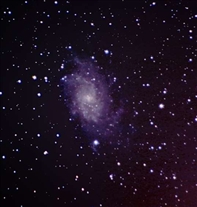 m033_300mm-f056-400iso-60deg.jpg
m033_300mm-f056-400iso-60deg.jpg (m033_300mm-f056-400iso-60deg.jpg)
M33 - Triangulum Galaxy
M33 is about 3 million light years distant. It is a large object in the sky and almost as close as M31 Andromeda galaxy, but it is too dim and spread-out to see with the unaided eye. It is said that it is part of our local group of galaxies and is gravitationally bound to M31 and us.
Messier 33
Spiral Galaxy M33 (NGC 598), type Sc, in Triangulum
Triangulum Galaxy
Right Ascension 01 : 33.9 (h:m)
Declination +30 : 39 (deg:m)
Distance 3000 (kly)
Visual Brightness 5.7 (mag)
Apparent Dimension 73x45 (arc min)
Excerpt from seds.org:
Probably discovered by Hodierna before 1654. Independently discovered by Charles Messier 1764.
The Triangulum Galaxy Messier 33 (M33, NGC 598) is another prominent member of the Local Group of galaxies. This galaxy is small compared to its big apparent neighbor, the Andromeda galaxy M31, and to our Milky Way galaxy, but by this more of average size for spiral galaxies in the universe. One of the small Local Group member galaxies, LGS 3, is possibly a satellite of M33, which itself may be a remote but gravitationally bound companion of the Andromeda galaxy M31.
M33 is approaching us (our Solar System) at 182 km/s according to R. Brent Tully, or at 179 +/-3 km/s according to NED. Corrected for our motion around the Milky Way's Galactic Center, it is approaching our Galaxy at 24 km/sec.
M33 was probably first found by Hodierna before 1654 (perhaps together with open cluster NGC 752). It was independently rediscovered by Charles Messier, and cataloged by him on August 25, 1764. Nevertheless, William Herschel, who otherwise carefully avoided to number Messier's objects in his survey, assigned it the number H V.17, on the ground of an observation dated September 11, 1784. Also because of the cataloging of Herschel, the brightest and largest HII region (diffuse emission nebula containing ionized hydrogen) has obtained a NGC number of its own: NGC 604 (William Herschel's H III.150); it is situated in the northeastern part of the galaxy; apparently the bright knot near the top of our image. This is one of the largest H II regions known at all: it has a diameter of nearly 1500 light-years, and a spectrum similar to the Orion nebula M42. Hui Yang (University of Illinois) and Jeff J. Hester (Arizona State University) have taken a photograph of NGC 604 with the Hubble Space Tepescope, resolving over 200 young hot massive stars (of 15 to 60 solar masses) which have recently formed here.
M33 was among the first "spiral Nebulae" identified as such by William Parsons, the Third Earl of Rosse; see his drawing. It was also among the first "nebulae" identified as galaxies, in which Cepheid variable stars were found; Edwin Hubble published a fundamental study in 1926 (Hubble 1926).
Several other knots in the spiral arms of M33 have been assigned their own NGC catalog numbers: NGCs 588, 592, 595, and NGC 603 (the latter is listed as nonexistent in the RNGC though, although they mention it was listed by Zwicky), as well as ICs 131, 132, 133, 134, 135, 136, 137, 139-40, 142, and 143 (NGC 2000.0 lists IC 134 and 139-40 as stellar, while the Webb Society Deep-Sky Observer's Handbook, Vol. 4 [Galaxies] shows IC 139-40 on the chart on p. 215, which is credited to Ronald J. Buta of McDonald Observatory, University of Texas). Some of them are identified in our map also. Kenneth Glyn Jones notes that they should be visible in 12.5-inch telescopes. The giant emission nebula NGC 595 was investigated by William H. Waller with the HST (e.g. Astronomy, June 1995, p. 16-18); with Hubble he resolved the hot massive stars that excite that nebula's gas to shine.
Our image, which was obtained by David Malin from photographic plates made with the Isaac Newton Telescope on La Palma, shows many of these objects in the spiral arms of this beautiful Sc spiral (NGC 604, for example, is the prominent red patch near the left edge in the upper half of our photo). Interested readers can obtain more detailed information on this image. By different processing, David Malin has enhanced various features in alternative images from this INT photo of M33.
The results of the Hipparcos satellite have lead to a revision of the cosmic distance scale, therefore also of our distance to M33: The current value is about 3.0 million light-years. Most sources give a distance of 2.3 to 2.4 million light-years, but the Sky Catalogue 2000.0 has more than 2.9 million light-years (900 kpc), which by chance may be closer after the new Cepheid distance recalibration, due to 1997 Hipparcos satellite results. Investigations of Cepheids in M33 of 1991 (Freedman et.al., 1991) have revealed that M33 is at a slightly greater distance from us than the Andromeda Galaxy M31. With our distance values, the distance of M33 from M31 is about 750,000 light-years. Assuming the former value, its angular dimension of 73 arc minutes in major axis (about 2.5 times the Moon's diameter) corresponds to about 50,000 light-years, half the diameter of the Milky Way. However, the faintest outlayers seem to reach more far out, so that the true diameter may be at least 60,000 light-years. The mass of the Triangulum Galaxy has been estimated between 10 and 40 billion solar masses.
The Triangulum galaxy M33 is of type Sc, and even a "late" representative of that type so that Tully classifies it as Scd (in the Nearby Galaxies Catalog). The pronounced arms exhibit numerous reddish HII regions (including NGC 604), as well as blueish clouds of young stars. Baade has also discovered Population II stars, and globular clusters have been found. Although no supernovae have yet been detected in the Triangulum galaxy, several supernova remnants have, and were cartographed by radio astronomers with high acuracy. At least 112 variables have been discovered in M33, including 4 novae and about 25 Cepheids. A strong X-ray source is also situated in this galaxy.
For the observer, this galaxy can be glanced with the naked eye under exceptionally good conditions; for most people, it is the most distant object visible to the naked eye (there are rare reports that some eagle-eyed stargazers managed to see M81 under exceptional conditions, but this is exceptional with all respects). It is outstanding in good binoculars, but as its considerable total brightness is distributed quite evenly over an area of nearly four times that covered by the full Moon, its surface brightness is extremely low. Therefore, it is difficult to impossible to view this galaxy in telescopes which do not allow low magnification - lowest is best for this object ! The best view of M33 the present author had was with a 6-inch refractor at magnification 25. M33 is also a most rewarding target for the astrophotographer, who can track down its spiral arms and brighter nebulae with considerably inexpensive equipment.
More ambitious observers with large telescopes (> 40 cm aperture) may try to track down some of M33's globular clusters; Rich Jakiel has tracked down 5 globular clusters in M33 with a 50-cm telescope.
m042___m043_-_orion_nebula_5.jpg
m042 & m043 - orion nebula 5.jpg (m042 & m043 - orion nebula 5.jpg)
m042_9x45sec-ed80f075_20d-800iso-nonr-f023_2ndnightap1200gto_firstlight-ed80.jpg
m042_9x45sec-ed80f075_20d-800iso-nonr-f023_2ndnightap1200gto_firstlight-ed80.jpg (m042_9x45sec-ed80f075_20d-800iso-nonr-f023_2ndnightap1200gto_firstlight-ed80.jpg)
M42 and M43
Kind of first light for the Orion ED80 f.7.5 with my Canon 20D from my backyard on my AP1200. It is 8x45sec aimages. Unguided.  (m051_adpadd.ps.jpg)
M51
LX200GPS 12" at f/6.3 with reducer and Canon 300d.
You can see that the stars are not round, which was a problem with my LX200.
Messier 51
Spiral Galaxy M51 (NGC 5194), type Sc, in Canes Venatici
Whirlpool Galaxy
Right Ascension 13 : 29.9 (h:m)
Declination +47 : 12 (deg:m)
Distance 37000 (kly)
Visual Brightness 8.4 (mag)
Apparent Dimension 11x7 (arc min)
Discovered 1773 by Charles Messier.
Excerpt from seds.org:
The famous Whirlpool galaxy Messier 51 (M51, NGC 5194) is one of the most conspicuous, and probably the most wellknown spiral galaxy in the sky.
M51 was one of Charles Messier's original discoveries: He discovered it on October 13, 1773, when observing a comet, and described it as a "very faint nebula, without stars" which is difficult to see. Its companion, NGC 5195, was discovered on March 21, 1781 by his friend Pierre Méchain, so that it is mentioned in Messier's 1781 catalog: `It is double, each has a bright center, which are separated 4'35". The two "atmospheres" touch each other, the one is even fainter than the other.' In addition to the description, in his personal copy of the catalog, Messier has added a small drawing, or sketch of the two "nebulae," M51 and NGC 5195, one of the rare cases a detailed drawing by Charles Messier of one of his objects is preserved. NGC 5195 was assigned an own catalog number by William Herschel: H I.186.
Occasionally, there is some confusion what is meant with the designation M51: The pair (justified by Messier's mention of both "nebulae") or the larger galaxy, NGC 5194. If the pair is meant, NGC 5194 is sometimes called "M51A", and NGC 5195 is then "M51B".
M51 is the dominating member of a small group of galaxies, which also contains M63 and a number of fainter galaxies. As it is about 37 million light years distant and so conspicuous, it is actually a big and luminous galaxy. The value of M51's (and the whole group's) distance is still not very well known. Our value, of 37 Mly, is based on photometric methods and e.g. given by Kenneth Glyn Jones. Some authors give significantly lower values (less than 20 Mly), but a recent (2001) STScI Press Release gave 31 million light years.
This galaxy was the first one where the spiral structure was discovered, in spring 1845 by Lord Rosse, who made a very careful and acurate painting. Therefore, M51 is sometimes referenced as Rosse's Galaxy or Lord Rosse's "Question Mark" - he is cited with this name (see, e.g., NED).
According to our present understanding, the pronounced spiral structure is a result of M51's current encounter with its neighbor, NGC 5195 (the fainter one in Messier's description). Due to this interaction, the gas in the galaxy was disturbed and compressed in some regions, resulting in the formation of new young stars. As is common in galactic encounters, spiral structure is preferably induced in the more massive galaxy. Halton Arp has included M51 as No. 85 in his Catalogue of Peculiar Galaxies as "Spiral with Large High-Surface-Brightness Companion".
For the amateur, M51 is easy and a showpiece if the sky is dark, but is quite sensitive for light pollution which easily makes it fade in the background. Under very good conditions, even suggestions of its spiral arms can be glanced with telescopes starting from 4-inch. Low magnification is best for viewing this pair.
The Hubble Space Telescope has investigated especially the central region of M51. Its compact nucleus is now classified as of Seyfert type 2.5. Newer HST investigations (published 2001) focus on investigation of the inner spiral arms and dust clouds, which are the birth sites of massive and luminous stars. ESA's ISO (Infrared Space Observatory) satellite has investigated the Whirlpool Galaxy in the infrared light.
Two supernova have been discovered in M51 so far:
On April 2, 1994, SN 1994I was discovered 14"E and 12"S of the nucleus of M51 by the Atlanta amateur astronomers Jerry Armstrong and Tim Puckett. It brightened to mag 12.8 and was classfied as of type Ic.
On June 27, 2005, German amateur Wolfgang Kloehr found SN 2005cs 15"W and 67.3"S of the nucleus of M51 as it was at mag 13.5 (and rising) - this supernova was found to be of type II by the analysis of its spectrum.
Hubble Space Telescope images of SN 1994I
Amateur images of supernova 1994I in M51
The companion galaxy, NGC 5195, has also produced one supernova, 1945A, which occurred on April 8, 1945, and reached 14th magnitude.
m051-adpadd16_ps_usm_lvl_spek_.jpg
m051-adpadd16_ps(usm,lvl,spek).jpg (m051-adpadd16_ps(usm,lvl,spek).jpg)
M51
This was taken from the 764mm (30") f/4.8 Challenger observatory scope. It is 16 images stacked. I beleive this was with a 300d camera. (m051supernova2005.gif)
(2005)
M51
764mm (30") f/4.8 Challenger observatory scope with Canon 300d.
You can see a supernova at pixel position 335, 327. This was the first supernova I'd imaged. Somewhere on this site there is an animation of the shot I took in April, 2005 and this shot in June, 2005 about three months apart, clearly showing the new "star". m051supernova2005animation.jpg
m051supernova2005animation.gif (m051supernova2005animation.gif)
M51 - with Supernova 2005
This should be an animated GIF, but since we switched to Shozam, I don't know how to get this to work.
Try this:
m057_127mmf121_20d-nr_240seciso1600_000002_ip-ddp4122-statdiff1515-addbal_5299-6189_0922.jpg
m057_127mmf121_20d-nr_240seciso1600_000002_ip-ddp4122-statdiff1515-addbal+5299-6189+0922.jpg (m057_127mmf121_20d-nr_240seciso1600_000002_ip-ddp4122-statdiff1515-addbal+5299-6189+0922.jpg)
M57 - Ring Nebula
The file title indicates that his was taken with the Orion 127mm f/ 12.1 Mak/Cas of a friend of mine. I don't believe this is correct due to the wide angle shown. It is more likely that this was an ED80 image with a focal reducer. m057_250mmf100_dsip2_30x15sec_4X.jpg
m057_250mmf100_dsip2_30x15sec_4X.jpg Enter image description for image (m057_250mmf100_dsip2_30x15sec_4X.jpg)
M57 - Ring Nebula
M57 planetary nebula taken from the Hume Observatory site using my AP1200 mount with Ron Dammann's 10" f/10 SCT. It is 30 x 15sec images (unguided) combined using Envisage and resampled by 4x. 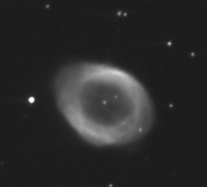 m057_250mmf100_dsip2_30x15sec_4X_crop.jpg
m057_250mmf100_dsip2_30x15sec_4X_crop.jpg Enter image description for image (m057_250mmf100_dsip2_30x15sec_4X_crop.jpg)
M57 - Ring Nebula
M57 planetary nebula taken from the Hume Observatory site using my AP1200 mount with Ron Dammann's 10" f/10 SCT. It is 30 x 15sec images (unguided) combined using Envisage and resampled by 4x. The image was cropped to show greater detail.
Messier 57
Planetary Nebula M57 (NGC 6720), type 4+3, in Lyra
Ring Nebula
Right Ascension 18 : 53.6 (h:m)
Declination +33 : 02 (deg:m)
Distance 2.3 (kly)
Visual Brightness 8.8 (mag)
Apparent Dimension 1.4x1.0 (arc min)
Excerpt from seds.org:
Discovered by Antoine Darquier de Pellepoix in 1779.
The famous ring nebula Messier 57 (M57, NGC 6720) is often regarded as the prototype of a planetary nebula, and a showpiece in the northern hemisphere summer sky.
Recent research has confirmed that it is, most probably, actually a ring (torus) of bright light-emitting material surrounding its central star, and not a spherical (or ellipsoidal) shell, thus coinciding with an early assumption by John Herschel. Viewed from this equatorial plane, it would thus more resemble the Dumbbell Nebula M27 or the Little Dumbbell Nebula M76 than its appearance we know from here: We happen to view it from near one pole.
This is contrary to the belief expressed e.g. in Kenneth Glyn Jones' book. There are even indications from investigations of deep observations such as George Jacoby's deep photos obtained at Kitt Peak National Observatory that the overall shape might be more that of a cylinder viewed along the direction of the axis than that of a ring, i.e., we are looking down a tunnel of gas ejected by a star at the end of its nuclear-burning life. Eventually, these observations have given evidence that the equatorial ring or cylinder has lobe-shaped extensions in polar directions, similar to those found in deep images of M76, but even more resembling other planetaries like NGC 6302, see e.g. the review by Sun Kwok (2000).
The deep observations also show an extended halo of material extending off to over 3.5 arc minutes (Hynes gives 216 arc seconds, quoting Moreno & Lopez, 1987), remainders of the star's earlier stellar winds. The halo was discovered in 1935 by J.C. Duncan (Duncan, 1935).
Our color photo (taken with the 200-inch Hale telescope at Mt. Palomar) shows that the material of the Ring is exposing a decreasing ionization level with increasing distance from the 100,000 to 120,000 K hot central star. The innermost region appears dark as it emits merely UV radiation, while in the inner visible ring, greenish forbidden light of ionized oxygen and nitrogen dominates the color, and in the outer region, only the red light of hydrogen can be excited.
The central star was discovered in 1800 by the German astronomer Friedrich von Hahn (1742-1805), with a 20-foot FL reflector. This object is a planet-sized white dwarf star, which shines at about 15th magnitude. It is the remainder of a sunlike star, probably once of more mass than our sun, which has blown away its outer envelopes at the end of its Mira-like phase of evolution. Now over 100,000 K hot, it will soon start to cool down, shine as a white dwarf star for a while of several billions of years, and then eventually end as a cold Black Dwarf.
As for most planetary nebulae, the distance to the Ring Nebula M57 is not very wellknown. In case of this nebula, however, attempt was made to relate its angular expansion rate of roughly 1 arc second per century with its radial expansion velocity. These results, however, were based on wrong assumptions of the geometry of this nebula, presuming a spherical shape. Therefore, until recently, only rough estimates could be made, based on various theoretical assumptions and models. The following distance values have been given: 4,100 ly (K.M. Cudworth 1974; Mallas/Kreimer), 1,410 ly (Kenneth Glyn Jones), 2,000 to 2,500 ly (Vehrenberg), 2,000 ly (Sky Catalogue 2000.0), "more than 2,000 ly" (Murdin/Allen's Catalogue of the Universe), 5,000 ly (Chartand/Wimmer's Skyguide), 3,000 ly (WIYN), and 1,000 to 2,000 ly (Sun Kwok, 2000). A good value for the distance still needs to be determined (e.g., parallax by Hubble Space Telescope), but recently improved CCD technics was used at the US Naval Observatory (USNO) to determine a trigonometric parallax for the central star of M57, yielding 2,300 ly (Harris et.al. 1997, see also STScI/Nasa, Jan 1999).
From the expansion rate of one arc second per century given above, the age of the nebula can be roughly estimated under the assumption of constant expansion. For its extension of 60x80 arc seconds, this yields a time of expansion of about 6,000 to 8,000 years.
As most planetary nebulae, the Ring is much brighter visually at magnitude 8.8 than photographically at only 9.7 mag; a consequence of the fact that most light is emitted in very few particular spectral lines (see the discussion in our planetary nebulae page). Assuming a distance of 2,300 lightyears, this corresponds to an absolute magnitude of -0.3 visually (+0.5 photographically), or an intrinsic brightness of about 50 to 100 times that of our Sun. Even the 14.7-mag central star, of the size of a terrestrial planet, is only little fainter than our Sun with an absolute magnitude of about +5 or 6. Its apparent dimension of 1.4 arc minutes corresponds to a linear diameter of 0.9 lightyears (5.5 trillion miles or 8.8 trillion km, or 60,000 Astronomical Units), the halo extending out to a diameter of 2.4 lightyears.
The mass of the nebular matter has been estimated at about 0.2 solar masses, the density at about 10,000 ions per ccm (cm^3). Its chemical composition has been determined as follows: On each Fluor (Fl) atom, the Ring Nebula contains 4.25 million atoms of Hydrogen (H), 337,500 Helium (He), 2,500 Oxygen (O), 1,250 Nitrogen (N), 375 Neon (Ne), 225 Sulfur (S), 30 Argon (Ar) and 9 Chlorine (Cl) atoms. It is expanding at 20 to 30 km/s, and approaching us at 21 km/s.
M57 images by Finnish astronomers have shown a star which is superimposed (before or behind) over the ring.
For amateurs, it is always a challenge to identify the faint central star of the Ring. Note Tom Polakis' photometric data of stars around M57 and the Photometry of M57 Field Stars, by Brian Skiff.
M57 was the second planetary nebula to be discovered (in January 1779), 15 years after the first one, M27. Antoine Darquier de Pellepoix (Darquier), who discovered the Ring Nebula only a few days before Charles Messier found and cataloged it, described it as "a dull nebula, but perfectly outlined; as large as Jupiter and looks like a fading planet." This comparison to a planet may have influenced William Herschel, who found the objects of this type resembling the planet newly discovered by him, Uranus, and introduced the name "Planetary Nebulae". Herschel described M57 as "a perforated nebula, or ring of stars;" this was the first mention of the ring shape. Oddly, the inventor of the name "Planetary Nebula" did not count this most prominent representative in this object class, but described it as a "curiosity of the heavens", a peculiar object. Herschel also identified some of the superimposed stars, and correctly assumed that "none [of them] seems to belong to it."
M57 is very easy to locate as it is situated between Beta and Gamma Lyrae, at about one-third the distance from Beta to Gamma. It can be seen with binoculars as an almost stellar object, difficult to identify just because of its small apparent diameter. In smaller amateur telescopes, the ring becomes apparent at about 100 magnification, with a darker middle; a 12th-mag star is east of the planetary nebula, about 1' of the center. If ever color is notable, the Ring Nebula appears slightly greenish, not unexpected because most of its light is emitted in few green spectral lines. Even in small scopes, a slight ellipticity can be noted, with major axis in a position angle of about 60 deg. With increasing aperture and under good condition, more and more detail becomes visible, but even in large instruments, the central star will be apparent only under exceptionally good conditions, or with the help of filters. In large instruments, several very faint foreground or background stars can be glimpsed within the nebula's extension under very good conditions.
Of the neighboring stars, Beta Lyrae (Sheliak) is a notable eclipsing binary, with components of spectral type B7 and A8, varying between mag 3.4 and 4.4 with a period of 12.91 days. Gamma Lyrae (Sulaphat, Arabic for "Tortoise") is a giant of spectral type B9 III and mag 3.2 with a mag 12 companion at 13.8" distance in position angle 300 deg. The 0.4' small and 14.4-mag faint galaxy IC 1296 is situated just 4' NW of M57 and can be found with large instruments.
m057_cr_ddmask_cropped.jpg
m057_cr_ddmask_cropped.jpg (m057_cr_ddmask_cropped.jpg)
M57 - Ring Nebula
764mm (30") f/4.8 Challenger observatory scope at Fremont Peak with Canon 300d.
Some hue rotation was done to accentuate and saturated some of the colors. (m057_ddmask.jpg)
M57 - Ring Nebula
764mm (30") f/4.8 Challenger observatory scope at Fremont Peak with Canon 300d.
Some hue rotation was done to accentuate and saturated some of the colors. (m057ring3_ps.jpg)
M57 - Ring Nebula
Taken with Orion 127mm f/12.1 Mak/Cas of a friend of mine. it is a single 5min exposure at 1600iso from my backyard with AP1200 mount unguided. Best m57 to date. The seeing was exceptional that night.
m057-ring_60deg_ed80f150_20d-nr_6x20min800iso_ip-adpadd-ddp11416-starsize-statdiff.jpg
m057-ring_60deg_ed80f150_20d-nr_6x20min800iso_ip-adpadd-ddp11416-starsize-statdiff.jpg (m057-ring_60deg_ed80f150_20d-nr_6x20min800iso_ip-adpadd-ddp11416-starsize-statdiff.jpg)
M57 - Ring Nebula
Orion ED80 f/15.0 (f/7.0 with 2" Orion Barlow). canon 20d 6 x 20min 800iso images with in-camera noise reduction. It was 60 degrees outside. m066_leotriplet__68deg_ed80f075_20d_9x480seciso1600_sigmed_bdf_ip-ddp2116_pe-despekmed1.jpg
m066_leotriplet__68deg_ed80f075_20d_9x480seciso1600_sigmed_bdf_ip-ddp2116_pe-despekmed1.jpg (m066_leotriplet__68deg_ed80f075_20d_9x480seciso1600_sigmed_bdf_ip-ddp2116_pe-despekmed1.jpg)
M66, M67 and the Leo Triplet Galaxies
Orion ED80 f/7.5, canon 20D. 4x8min 1600iso stacked in Images Plus 2.83. Possibly guided via ST80 and DSI2Pro on AP1200.
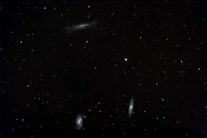 leotriplet-gxy180SecISO1600_2xAvg_ip-ddp5919.jpg
leotriplet-gxy180SecISO1600_2xAvg_ip-ddp5919.jpg Enter image description for image (leotriplet-gxy180SecISO1600_2xAvg_ip-ddp5919.jpg)
(01/15/2008)
M065, m066, Leo Triplet of galaxies.
First light for the TEC 140 f/7 scope. Seeing was bad. This is 2x180sec images at 1600iso averaged with Images Plus 2.83 and ddp at 5919.
Messier 66
Spiral Galaxy M66 (NGC 3627), type Sb, in Leo
in the Leo Triplett
Right Ascension 11 : 20.2 (h:m)
Declination +12 : 59 (deg:m)
Distance 35000 (kly)
Visual Brightness 8.9 (mag)
Apparent Dimension 8x2.5 (arc min)
Discovered 1780 by Charles Messier.
Excerpt from seds.org:
Messier 66 (M66, NGC 3627), together with its neighbors M65 and NGC 3628, forms a most conspicuous triplet of galaxies, the Leo Triplett or M66 group, located at a distance of about 35 million light years.
M66 is considerably larger than its neighbor, M65, and has a well developed but not well defined central bulge, and is therefore classified Sb. Obviously its spiral arms are deformed, probably because of the encounters with its neighbors. They seem to be distorted and displaced above the plane of the galaxy. Note how one of the spiral arms seems to pass over the left side of the central bulge. Much dust is visible here, as well as a few pink nebulae, signs of star formation, near the end of one of the arms.
This image was obtained by David Malin with the 3.9-meter Anglo Australian Telescope; interested readers may obtain more detailed information on this image.
Together with its neighbor M65, M66 has been discovered by Charles Messier, who cataloged it on March 1, 1780, remarks that he missed these two objects in 1773, when a comet passed between them on November 1 to 2, 1773, probably because of the light of the comet. Because of a dubious error, Admiral Smyth has assigned this discovery of M65 and M66 (and M68) to Pierre Méchain, a view which was adopted by Kenneth Glyn Jones somewhen in the 1960s, and consequently, in many modern sources, despite the fact that Messier doesn't acknowledge such a prior sighting, which he did in all other cases.
Three supernovae have appeared in this galaxy:
1973R which was of type II and reached mag 15 was found on Dec 12, 1973.
1989B was discovered on Jan 31, 1989 and became as bright as mag 12.2 on Feb 1, 1989.
1997bs was discovered by the Lick Observatory Supernova Search Team as it occurred on April 15, 1997 at 13" west, 67" south of the galaxy's center and reached mag 17.0; this was of peculiar type IIn.
Halton Arp has included M66 in his Catalogue of Peculiar Galaxies as entry No. 16. Moreover, he assigned the number 317 to the Leo Triplett (M66 together with M65 and NGC 3628).
Messier 65
Spiral Galaxy M65 (NGC 3623), type Sa, in Leo
in the Leo Triplett
Right Ascension 11 : 18.9 (h:m)
Declination +13 : 05 (deg:m)
Distance 35000 (kly)
Visual Brightness 9.3 (mag)
Apparent Dimension 8x1.5 (arc min)
Discovered 1780 by Charles Messier.
Messier 65 (M65, NGC 3623), together with its neighbors M66 and NGC 3628, forms a most conspicuous triplet of galaxies, the Leo Triplett or M66 group, located at a distance of about 35 million light years.
Although it is close to and thus under the gravitational influence of its neighbors, M65 looks like a very "normal" Sa type spiral and seems to have felt little influence. It has a prominent central lense and tightly wound spiral arms, plus a prominent dust lane marking the facing edge. The luminous disk is dominated by a smooth old stellar population. Near the lane, some knots are visible, which, according to J.D. Wray, may be associated with star forming regions. The lane may hide regions of star formation usually associated with such features in spiral galaxies.
Our image of M65 was obtained by David Malin with the Anglo Australian Telescope; interested readers may obtain more detailed information on our image.
M65, together with its neighbor, M66, has been discovered by Charles Messier, who cataloged it on March 1, 1780, describes it as "very faint nebula without stars." Because of a dubious error, Admiral Smyth has assigned this discovery of M65 and M66 (and M68) to Pierre Méchain, a view which was adopted by Kenneth Glyn Jones somewhen in the 1960s, and consequently, in many sources, despite the fact that Messier doesn't acknowledge such a prior sighting, which he did in all other cases.
Halton Arp includes M65 in his entry number 317 of his Catalogue of Peculiar Galaxies, which denotes the Leo Triplett.
NGC 3628
Spiral Galaxy NGC 3628 (= H V.8 = Arp 317), type Sc, in Leo
Right Ascension 11 : 20.3 (h:m)
Declination +13 : 36 (deg:m)
Distance 35000.0 (kly)
Visual Brightness 9.5 (mag)
Apparent Dimension 14.0 x 3.6 (arc min)
Discovered by William Herschel in 1784.
NGC 3628 forms a conspicuous group with M65 and M66, the Leo Triplet or M66 group (named after the brightest of the three).
NGC 3628 is the faintest and most difficult in the group, just faint enough to have escaped Messier's small telescopes (although it may be that his later instruments might have shown it, if he had ever looked at this place under very good conditions). Thus its discovery was left to William Herschel who cataloged it as H V.8 following its discovery on April 8, 1784.
NGC 3628 is seen edge-on. A conspicuous band of dark dust clouds form a broad equatorial band, which obscures the galaxy's bright central region, and hides most of the bright young stars in its spiral arms. The dust band, or belt, is obviously distorted and deformed in the outer regions of the galaxy. The reason for this deformation is evidently the gravitational interaction with its two bright neighbors, M65 and M66.
Our image was obtained by David Malin with the Anglo-Australian Telescope. This image is copyrighted and may be used for private purpose only. For any other kind of use, including internet mirroring and storing on CD-ROM, please contact the Photo Permissions Department (photo at aaoepp.aao.gov.au) of the Anglo Australian Observatory.
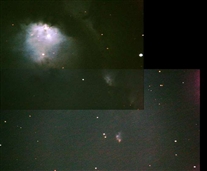 (m078_mcneils_mosaic4.jpg)
McNeil's Nebula and M78
This was a new nebula near M78. A 17 year old boy in the mid-west discovered this new nebula. Since that time, it has extinguished and is no longer visible. It is problaby a new star trying to start up.
Messier 78
Starforming Nebula M78 (NGC 2068), a reflection nebula, with Open Star Cluster, in Orion
Right Ascension 05 : 46.7 (h:m)
Declination +00 : 03 (deg:m)
Distance 1.6 (kly)
Visual Brightness 8.3 (mag)
Apparent Dimension 8x6 (arc min)
Discovered 1780 by Pierre Méchain.
Excerpt from seds.org:
Messier 78 (M78, NGC 2068) is the brightest diffuse reflection nebula in the sky, situated in the rich constellation Orion.
This object was discovered by Pierre Méchain in early 1780. Charles Messier added it to his catalog on December 17, 1780.
M78 belongs to the Orion complex, a large cloud of gas and dust centered on the Orion Nebula M42/M43, and is about 1,600 light years distant. It is the brightest portion of a vast dust cloud which includes NGC 2071 (northeast, lower right in our image), NGC 2067 (close northwest), and very faint NGC 2064 (southwest), all visible in our image. Together with some other nebulae, including NGC 2024 (Orion B) near Zeta Orionis (sometimes called the Flame Nebula), all these nebulae are associated with the molecular cloud LDN 1630 (from Lynds' Catalogue of Dark Nebula), a part of the Orion complex.
As a reflection nebula, M78 is a cloud of interstellar dust which shines in the reflected and scattered light of bright blue (early B-type) stars, among them the brightest, HD 38563A, and second-brightest HDE 38563B, both of about 10th visual apparent magnitude. The nature of M78 as a reflection nebula was discovered by Vesto M. Slipher of Lowell Observatory in 1919 (Slipher 1919), by the investigation of its spectrum: M78 exhibits a continuous spectrum, which resembles that of the bright stars enlightening it. At its distance, M78 measures almost 4 light years in extension.
The image in this webpage was obtained by Evered Kreimer with a 12.5-inch Newtonian from Arizona in the mid-1960s. This image acquired some late fame in February 2004 on the following occasion: Jay W. McNeil disvcovered a supposedly "newly" nebula near M78, within the field of this image (McNeil 2004), which could not be found in a number of images taken at various epochs. However, the nebula was soon found to be obvious in the Kreimer image displayed in this page by a considerable number of attentive readers of these webpages, demonstrating that it had been in place at the time when this image was taken, and Jay McNeil had discovered another outburst of the young star feeding it (a so-called Herbig-Haro object). Meanwhile, McNeil's nebula has faded again.
In and near the nebula M78, 45 low mass stars with hydrogen emission lines, irregular variables similar to the star T Tauri, have been detected. Stars of this type are main sequence stars which vary in brightness (by about 3 magnitudes) and spectral type (which is about F or G, and similar to the chromosphere of our sun), are 4 to 5 times brighter than their spectral type would suggest, and associated with nebulosity which may be bright or dark. Probably these are very young stars which are still in their formation process.
Infrared investigations have given a clearer image of the cluster of young stars which have formed in this nebula. From 2.2-micron investigations of the Molecular Cloud associated with M78, LDN 1630 (Orion B), performed with Kitt Peak National Observatory's 1.3-m IR telescope Lada et.al. (1991) concluded that much of the young, embedded star formation is occurring in clusters, including the formation of lower mass stars. They counted a number of 192 stars, spread over an area of 7' angular diameter. After this paper, Archinal and Hynes (2003) call the open star cluster in M78 "[LDEG91] 3."
A large number of dramatic outflow sources are found in the region of M78; these so-called Herbig-Haro objects are presumably jets of matter ejected from young stars embedded in the nebulous matter of M78 where they have just formed. The discoveries by Zhao et al. (1999) brought the number of known Herbig-Haro objects in M78 to 17. A gorgeous IR image of M78 and the whole region was created by S. Van Dyk of IPAC with the 2MASS IR Telescope; these data provide an even deeper insight into the star formation process in M78.
M78 is not difficult to locate from Zeta Orionis, also named Alnitak, the easternmost star of Orion's Belt; M78 is situated about 2 degrees north and 1 1/2 degrees east of this star; a chain of 3 stars of mag 5..6, northward from Zeta, may help locating it. Alternatively, it is found roughly 1/2 deg North and 3 3/4 deg East of Delta Orionis, the NW most belt star.
Visually, M78 resembles a faint comet. It is just visible in binoculars under good conditions, as a very dim patch. Small telescopes already show it remarkably bright, and reveal the two illuminating stars, lying North preceding (NW) and South following (SE) like a double nucleus in the compact "comet head" part of M78; suggestions of a short and broad "tail" appear to reach to the South preceding (SW) end. The other nebulae in this field require a very dark sky and are much more difficult to see than M78; under very good conditions, a 4-inch can reveal NGC 2071, and suggestions of haze around M78. Stars are fewer to the west, an indication that in this region dark nebulae seem to obscure the stellar background. About 1 3/4 deg East of M78, open cluster NGC 2112 is found; this cluster is of about 9th mag and 11' in diameter, lies behind M78 at a distance of about 2800 light-years, and is much older: Estimated at about 2 billion years.
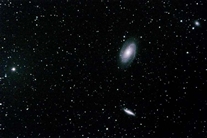 m081_52deg_ed80f075_20d_nr_dark_1x20miniso1600_ps-curve_pe-despekmed1.jpg
m081_52deg_ed80f075_20d_nr+dark_1x20miniso1600_ps-curve_pe-despekmed1.jpg (m081_52deg_ed80f075_20d_nr+dark_1x20miniso1600_ps-curve_pe-despekmed1.jpg)
M81 and M82
Messier 82
Irregular Galaxy M82 (NGC 3034), type Ir-II, in Ursa Major
Cigar Galaxy
Right Ascension 09 : 55.8 (h:m)
Declination +69 : 41 (deg:m)
Distance 12000 (kly)
Visual Brightness 8.4 (mag)
Apparent Dimension 9x4 (arc min)
Discovered by Johann Elert Bode in 1774.
Excerpt from seds.org:
Messier 82 (M82, NGC 3034) is a remarkable galaxy of peculiar type in constellation Ursa Major. It is usually classified as irregular, though probably a distorted disk galaxy, and famous for its heavy star-forming activity, thus a prototype member of the class of starbursting galaxies.
Forming a most conspicuous physical pair with its neighbor, M81 (THE showpiece galaxies for many Northern hemispherers), this galaxy is the prototype of an irregular of the second type, i.e. a "disk" irregular. Its core seems to have suffered dramatically from a semi-recent close encounter with M81, being in a heavy starburst and displaying conspicuous dark lanes. This turbulent explosive gas flow is also a strong source of radio noise, discovered by Henbury Brown in 1953. The radio source was first called Ursa Major A (strongest radio source in UMa) and cataloged as 3C 231 in the Third Cambridge Catalogue of Radio Sources.
In the infrared light, M82 is the brightest galaxy in the sky; it exhibits a so-called infrared excess (it is much brighter at infrared wavelengths than in the visible part of the spectrum). This behaviour can also be observed for the companion of M51, NGC 5195, and the peculiar galaxy NGC 5128 (Centaurus A). The visual appearance is that of a silvery sliver, as John Mallas decribed it.
Recently, over 100 freshly-formed (young) globular clusters have been discovered with the Hubble Space Telescope. Their formation is probably another effect triggered by the encounter with M81. It was estimated that the most recent tidal encounter occurred between about 50 and several 100 million years ago: STScI's most recent number was 600 million years, when the 100-million-year-long period of heavier interaction began.
As a member of the M81 group, M82 is 12 million light years distant.
M82 was discovered on December 31, 1774 by Johann Elert Bode together with M81; he described it as a "nebulous patch", about 0.75 deg away from M81, which "is very pale and of elongated shape," and cataloged it as No. 18 in his catalog. Pierre Méchain independently rediscovered both galaxies as nebulous patches in August 1779 and reported them to Charles Messier, who added them to his catalog after his position measurement on February 9, 1781.
M82 belongs to those few Messier objects which have been assigned a Herschel number, H IV.79, based on an observation of September 30, 1802, while William Herschel usually carefully avoided to give his numbers to Messier objects.
William Parsons, the Third Earl of Rosse, was the first to remark on the dark dust lanes and patches visible in the central part of M82.
Halton Arp has included M82 as No. 337 in his Catalogue of Peculiar Galaxies.
One false and one true supernova have been reported in M82 so far:
Lebofsky, Rieke, and Kailey reported the discovery of a supernova, 1986D, which should have occurred in M82, and is e.g. listed in Kenneth Glyn Jones' book. However, this "SN" turned out to be a false alarm. Instead, a slightly variable 2-micrometer source had fooled the discoverers.
Supernova 2004am was discovered lately on images taken at Lick Observatory on November 21, 2003, when it was at mag 17.0. 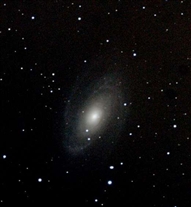 m81-gxy240-600secISO800_4xAdpAdd.jpg
m81-gxy240-600secISO800_4xAdpAdd.jpg Enter image description for image (m81-gxy240-600secISO800_4xAdpAdd.jpg)
(01/15/2008)
M81 galaxy 4min - 10 min exposures with adaptive add with Images Plus. TEC 140 f/7.0, canon 20D prime focus on AP1200 mount. 4 images stacked.
This is the second image with the TEC 140.
Messier 81
Spiral Galaxy M81 (NGC 3031), type Sb, in Ursa Major
Bode's Galaxy
Right Ascension 09 : 55.6 (h:m)
Declination +69 : 04 (deg:m)
Distance 12000 (kly)
Visual Brightness 6.9 (mag)
Apparent Dimension 21x10 (arc min)
Discovered by Johann Elert Bode in 1774.
Excerpt from seds.org:
Messier 81 (M81, NGC 3031) in Ursa Major is one of the most conspicuous galaxies in the sky, and one of the nearest beyond the Local Group. It is a conspicuous spiral galaxy.
M81 is one of the easiest and most rewarding galaxies to observe for the amateur astronomer on the northern hemisphere, because with its total visual brightness of about 6.8 magnitudes it can be found with small instruments.
Brian Skiff of Lowell Observatory reports that he could see M81 with the unaided naked eye under exceptionally good viewing conditions (i.e., clear dark skies), and is at least the fourth observer who reported to have done so ! Dan Gerhards reports that at the Oregon Star Party of 2006, another two observers have managed to spot it, and knows of a third amateur who claims to have seen it, bringing the total to at least seven observers.
The pronounced grand-design spiral galaxy M81 forms a most conspicuous physical pair with its neighbor, M82, and is the brightest and probably dominant galaxy of a nearby group called M81 group. A few tens of million years ago, which is semi-recently on the cosmic time scale, a close encounter occurred between the galaxies M81 and M82. During this event, larger and more massive M81 has dramatically deformed M82 by gravitational interaction. The encounter has also left traces in the spiral pattern of the brighter and larger galaxy M81, first making it overall more pronounced, and second in the form of the dark linear feature in the lower left of the nuclear region. The galaxies are still close together, their centers separated by a linear distance of only about 150,000 light years.
M81 is the first of the four objects originally discovered by Johann Elert Bode, who found it, together with its neighbor M82, on December 31, 1774. Bode described it as a "nebulous patch", about 0.75 deg away from M82, which "appears mostly round and has a dense nucleus in the middle," and included it as No. 17 in his list. Pierre Méchain independently rediscovered both galaxies as nebulous patches in August 1779 and reported them to Charles Messier, who added them to his catalog after his position measurement on February 9, 1781.
Using the Hubble Space Telescope, a team under Wendy Freedman of the Carnegie Institution of Washington has investigated 32 Cepheid variables in M81 and determined the distance to be 11.0 million light years, in 1993 well before the HST was refurbished. Together with the new distance scale correction implied by the results of ESA's Hipparcos satellite, the true distance of M81 is probably closer to 12.0 million light years. See the H0 Key Project Team's work on M81 (paper 1 and 2, 1994).
On Sunday, March 28, 1993, a type II supernova (1993J) occured in M81, which was discovered by the Spanish amateur astronomer Francisco Garcia Diaz from Lugo (Spain), and reached a brightness of about mag 10.5 in its maximum. The remnant of this supernova was imaged in the radio light at 3.6 cm wavelength from roughly six to 18 months after the explosion, with a global Very Long Baseline Interferometer (VLBI) array of radio telescopes in Europe and North America.
Investigations performed in 1994 have indicated that M81 has probably only little dark matter, as its rotation curve was found to fall off in the outer regions; this is in contrast to many galaxies, including our own Milky Way, for which the rotation curve increases outward. To explain the velocity of the stars in these regions, the galaxy must have a certain amount of mass. However, the total mass observed in luminous matter - stars and nebulae - is typically insufficient to explain this behaviour; thus it is assumed that there is a significant portion of mass in galaxies is non-luminous, dark matter (or at least low-luminosity matter). For M81, the percentage of dark matter is now estimated to be lower than average.
In 1995, Perelmuter and Racine investigated the region around M81 for globular clusters, and found about 70 candidate objects for the globular cluster system of M81 (Perelmuter and Racine, 1995). They estimate the total population at 210 +/- 30 globulars.
In December 1990, the ASTRO-1 Space Shuttle mission (STS-35) transported telescopes into the Earth's orbit, including the UIT (Ultraviolet Imaging Telescope) which obtained images of M81 (in the ultraviolet light; these were compared with the visible light image, and combined to an interesting and informative overlay; an animation [433 k MPG] showing a morphing from the UV to visual image of M81 is available). Previously, M81's UV radiation had been investigated by the Soviet Astron orbital observatory. Bill Keel has assembled a series of images of M81 in the different parts of the electromagnetic spectrum from the radio part to the X-rays region.
m081_ed80-f075-ap1200-unguide_20d-800iso-31x45sec-nr_ip-dark_adpadd_ps_lvl-crv-astroact_2_crop_ip-multires61-40p9-15p7.jpg
m081_ed80-f075-ap1200-unguide_20d-800iso-31x45sec-nr_ip-dark_adpadd_ps_lvl-crv-astroact_2_crop_ip-multires61-40p9-15p7.jpg (m081_ed80-f075-ap1200-unguide_20d-800iso-31x45sec-nr_ip-dark_adpadd_ps_lvl-crv-astroact_2_crop_ip-multires61-40p9-15p7.jpg)
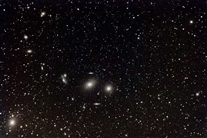 m086-virgo_60deg_ed80f050_20d-nr_1x40miniso1600_ip-flat.jpg
m086-virgo_60deg_ed80f050_20d-nr_1x40miniso1600_ip-flat.jpg (m086-virgo_60deg_ed80f050_20d-nr_1x40miniso1600_ip-flat.jpg)
M86
Messier 86
Lenticular (S0) Galaxy M86 (NGC 4406), type S0, in Virgo
Right Ascension 12 : 26.2 (h:m)
Declination +12 : 57 (deg:m)
Distance 60000 (kly)
Visual Brightness 8.9 (mag)
Apparent Dimension 7.5x5.5 (arc min)
Discovered 1781 by Charles Messier.
Excerpt from seds.org:
Messier 86 (M86, NGC 4406) is one ogf the brightest member galaxies of the Virgo Cluster og Galaxies, and situated close to that cluster's apparent center.
M86 has been discovered and cataloged by Charles Messier on March 18, 1781 when he also cataloged 7 more nebulous objects in the same region of the sky, all member galaxies of the Virgo Cluster, and in addition, globular cluster M92.
This bright giant galaxy is either an elliptical of type E3 or a lenticular galaxy of type S0_1(3); modern classifications apparently tend more to the lenticular classification, NED gives both classes. It has a conspicuous system of faint globular clusters, suggestions of which can be just seen in the DSSM image of this galaxy. However, this system of globulars is far less populated than that of its giant neighbor to the SE, M87. To the lower left is a very small and faint dwarf elliptical companion. Several condensations may be found around this galaxy in our image, especially to the lower part, and the DSSM photo (here to the upper edge), they may be globular clusters belonging to this galaxy.
M86 lies well in the heart of the Virgo Cluster of galaxies and forms a most conspicuous group with another giant, M84. Below M86 in our image is NGC 4402, a dim (11.5 mag) edge-on spiral. This group may be viewed in one field even at medium power, so that it is often photographed and we have more images including M84 and M86. Deep images of this group have revealed that these galaxies are actually much larger than indicated in conventional images, as the one in this page. In addition, we have images of the whole central part of the Virgo Cluster: M87 together with Markarian's chain around M84 and M86.
M86 is the galaxy which has the fastest approaching velocity, and thus the highest blue shift, of all Messier galaxies (and thus all Messier objects): It is approaching us at 419 km/sec ! (Sky Catalogur 2000.0; NED has a slightly lower value of 281 km/sec which makes it second to M90.) Holmberg (1964) has therefore speculated that it should be a close foreground galaxy and not a Virgo cluster member. This speculation has been referred to, and occasionally been adopted, by several sources, including George R. Kepple's and Glen W. Sanner's Observer's Guide. However, the present authors join the view of most modern sources, including the Sky Catalogue 2000.0, R. Brent Tully's Nearby Galaxies Catalog, Becvar's earlier Atlas Coeli, and (implicitely) the Webb Society's Deep Sky Observer Handbook (which has it in the Virgo Cluster description), and thinks it is just this high approach velocity which indicates that M86 is most probably a true cluster member, because of the following reason: In this case, the high velocity value would indicate that M86 is moving at a peculiar velocity of more than 1500 km/sec, which points by chance in a direction toward us. But this is not totally uncommon in huge clusters of galaxies as the Virgo cluster, because due to its enormous mass, this huge agglomeration of mass has a strong gravitational field. This strong gravitational field could easily accelerate a galaxy to the high velocity observed for M86; it would be much more difficult to find an explanation for such a high velocity for a field galaxy !
The Virgo cluster membership of M86 is also suggested by its more or less obvious interaction with the intergalactic gaseous matter in the Virgo cluster, which was reported from X-ray observations, discovered by Forman et.al. (1979); for a recent review see e.g. Rangarajan et.al. (1995). Moreover, M86 does not hold the record: Another Virgo cluster member, IC 3258, approaches us at 517 km/sec. Our Galaxies in the Virgo Cluster page lists more fastly approaching (and receding) Virgo Cluster members.
The X-ray gas tail of M86 is dramatically apparent in recent Chandra X-ray Observatory images of this galaxy.
Additional evidence for M86's Virgo Cluster membership may be derived from deep images of this galaxy which show slight disturbations of its faint outskirts, probably caused by gravitational interaction with its neighbors.
On deep images like this one, the outskirts of M84 and M86 seem to overlap; the angular distance between their centers of about 16.5 arc min corresponds to a projected distance of only roughly 300,000 light years. This, however, is probably a perspectivic effect, as otherwise their outlayers would be even much more distorted; there is probably some radial distance, or distance difference from us, between these two galaxies; it is not known which one is a bit closer to, and which a bit farther away from us.
On M86's fast motion through the intergalactic medium of the Virgo Cluster (the "Intra-Cluster Matter", ICM), the galaxy's interstellar matter collides at high velocity with this material, and is probably "ram-pressure stripped" from the galaxy (Rangarajan et.al. 1995). On this occasion, the matter is heated. Dust within this matter, previously held within colder gas clouds, is probably destroyed when the matter heats during the collision. Analysis of the ram pressure indicates that, in addition to its peculiar radial velocity with respect to the Virgo Cluster, M86 may have a tangential velocity component of about 500 km/sec in southward direction.
M86, together with M84, can be found rather easily, by pointing your telescope almost exactly half-way between Denebola (Beta Leonis) and Vindemiatrix (Epsilon Virginis). Both galaxies will show up in the same low (or medium) power eyepiece, and can serve as starting point for Observing the Virgo Cluster. Alternatively, you can find M84 and M86 from the "Big T" asterism including 6 Comae Berenices which is near M98, M99, and M100 at 1 deg south and 1.5 deg East of this asterism's "Southern Tip" star. Or both these galaxies are easily found from M87 which is about 1 degree southeast.
Virgo Cluster and M86
Orion ED80 f/5.0 with Canon 20d-nr. A single 40-min exposure at 1600 iso. Temp was 60degrees. There are well over a hundred galaxies in this image. It was taken with the Meade 6.3 focal reducer or the Taurus Tracker 3 with its 6.5 reducer. Guided with Orion ST80 and Meade DSI2pro and MaximDL. 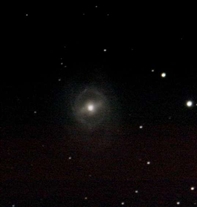 m095_45deg_ed80f150_20d-nonr_6x20min800iso_med-ddp1200.jpg
m095_45deg_ed80f150_20d-nonr_6x20min800iso_med-ddp1200.jpg (m095_45deg_ed80f150_20d-nonr_6x20min800iso_med-ddp1200.jpg)
M95
Orion ED80 f/7.5 with Barlow (f/15.0), canon 20D w/o NR. 6x20min 800iso exposures stacked with Images Plus 2.83. Guided with ST80/DSI2Pro on AP1200 mount.
M95 is a barred spiral galaxy with nearly circular arms surrounding the inner region. It is estimated this galaxy is 38 million lights years away. M95 and M96 are nearly in the same direction in the constellation of Leo and are also neighbors to one another. If you lived in the plane of this galaxy at one end of the bar, you might see your "milky way" look very bright looking along the bar. In our own galaxy, you can see the difference along the plane of the galaxy depending on the direction you look- but the difference is a bit more subtle here. Other barred spiral galaxies in the Messier catalogue include M91, M58 and M109.
M95 was one of the galaxies in the key project of the Hubble Space Telescope for the determination of the Hubble constant: the HST was employed to look for Cepheid variables and thereby determine this galaxy's distance. M95 is a barred spiral of type SBb, or SB(r)ab according to de Vaucouleurs' classification, with nearly circular arms. Alan Sandage, in the Hubble Atlas of Galaxies, calls it a "typical ringed galaxy".
Messier 95
Spiral Galaxy M95 (NGC 3351), type SBb, in Leo
Right Ascension 10 : 44.0 (h:m)
Declination +11 : 42 (deg:m)
Distance 38000 (kly)
Visual Brightness 9.7 (mag)
Apparent Dimension 4.4x3.3 (arc min)
Discovered by Pierre Méchain in 1781.
Excerpt from seds.org:
Messier 95 (M95, NGC 3351) is a beautiful barred spiral galaxy situated in constellation Leo, and one of the fainter Messier Objects.
Pierre Méchain discovered M95, together with M96, March 20, 1781. Consequently, Charles Messier included it in his catalog on March 24, 1781.
M95 is a barred spiral of type SBb, or SB(r)ab according to de Vaucouleurs' classification, with nearly circular arms. Alan Sandage, in the Hubble Atlas of Galaxies, calls it a "typical ringed galaxy". Its overall appearance is quite similar to M91 except that M95 has more pronounced spiral structure.
M95 is a member of the Leo I or M96 group, which also contains M96, M105 and a number of fainter galaxies.
Barred spiral galaxy M95 was one of the galaxies in the key project of the Hubble Space Telescope for the determination of the Hubble constant: the HST was employed to look for Cepheid variables and thereby determine this galaxy's distance. A preliminary result has been obtained and published in 1996-97 by the HST H0 Key Project Team (paper VII, 1997). Their result, corrected for the semi-recent adjustment of the Cepheid brightness zero point by ESA's Hipparcos astrometrical satellite, is a distance of 35.5+-3.1 million light years. This is in semi-good agreement with the value of about 41 million light years (after correction for Hipparcos results) which had been obtained earlier by Nial R. Tanvir for its neighbor M96, and implies a distance of all the galaxies in the Leo I group of about 38 million light years.
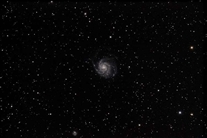 m101_63deg_ed80f075_20d-nr_8x20min_sigmed.jpg
m101_63deg_ed80f075_20d-nr_8x20min_sigmed.jpg (m101_63deg_ed80f075_20d-nr_8x20min_sigmed.jpg)
M101 - Pinwheel Galaxy
ED80 f7.5, Canon 20D-nr. 8x20min images at 1600iso, taken at Shingletown. Guided with ST80/DSI2Pro on AP1200.
Messier 101
Spiral Galaxy M101 (NGC 5457), type Sc, in Ursa Major
Pinwheel Galaxy
Right Ascension 14 : 03.2 (h:m)
Declination +54 : 21 (deg:m)
Distance 27 (mly)
Visual Brightness 7.9 (mag)
Apparent Dimension 22.0 (arc min)
Discovered by Pierre Méchain in 1781.
Excerpt from seds.org:
Messier 101 (M101, NGC 5457) was discovered by Pierre Méchain on March 27, 1781, and added as one of the last entries in Charles Messier's catalog. It was one of the first "spiral nebula" identified as such, in 1851 by William Parsons, the third Earl of Rosse.
Although extended 22 arc minutes on photos and quite bright, only the central region of this galaxy is visible in smaller telescopes, best at low powers. Suggestions of the spiral arms can be glimpsed in telescopes starting from 4 inch as nebulous patches. Several of these patches (i.e., spiral arm fragments) were assigned their own catalog numbers by William Herschel and later observers; according to the NGC and Burnham, there are 9 such numbers, 3 of which go back to Herschel who has found them on April 14, 1789, while the RNGC states that five of the others don't exist (ne); it mentions however that deVaucouleurs has them as knots: NGC 5447 (H III.787), 5449 (ne), 5450 (ne), 5451 (ne), 5453 (ne), 5455, 5458 (ne), 5461 (H III.788), 5462 (H III.789), and 5471.
On photographs, however, the Pinwheel Galaxy M101 is revealed as one of the most prominent Grand Design spirals in the sky. While quite symmetric visually and in very short exposures which show only the central region, it is of remarkable unsymmetry, its core being considerably displaced from the center of the disk. Halton Arp has included M101 as No. 26 in his Catalogue of Peculiar Galaxies as a "Spiral with One Heavy Arm".
M101 is the brightest of a group of at least 9 galaxies, called the M101 Group. The brightest companions are NGC 5474 (type Sc, 10.85 mag vis) to the SSE and NGC 5585 (Sa, 11.49 mag; Glyn Jones and Burnham misprinted this as 5485) to the NE. Other probable group members are NGC 5204 (Ir, 11.26), NGC 5238 (SB(d)m, 13.35p), NGC 5477 (Ir+, 13.8), UGC 8508 (Ir+, 14.5 p), Holmberg IV (UGC 8837, Ir+, 13.1 p), and UGC 9405.
The distance of M101 has been determined by the measurement of Cepheid variables with the Hubble Space Telescope in 1994/95 to be about 24 +/- 2 million light years, by the HST H0 Key Project Team (paper III, 1996). Kenneth Glyn Jones mentions earlier Earth-bound attempts of 1986, when two Cepheids were claimed to have been detected (yielding distance estimates between 20 and 26 million light years). It is also in good agreement with a distance determined from the Planetary Nebula Luminosity function, by Feldmeier, Ciardullo and Jacoby (1996) which is 25.1 +/- 1.6 million light years. According to the recent recalibration of the Cepheid distance scale, the "true" distance of M101 should be closer to a 10 percent higher value (27 million light years).
At the new distance from the HST and Hipparcos, it has a linear diameter of over 170,000 light years and is thus among the biggest disk galaxies, and its total apparent visual brightness of 7.9 mag corresponds to an absolute brightness of -21.6 magnitudes, or a luminosity of about 30 billion (3*10^10) times that of our sun.
Three supernovae have been discovered in M101: The first one, SN 1909A, appeared on January 26, 1909 and was discovered by Max Wolf; it was of peculiar type and reached mag 12.1 (Glyn Jones reports that the discovery took place in February, and the SN reached only mag 13.5). The second supernova 1951H was of type II, occurred in September 1951 and reached mag 17.5, while the third, SN 1970G, also type II, was discovered on July 30, 1970 by Michael Lovas, and reached mag 11.5. The remnant of Supernova 1970G was later detected in X-ray light and e.g. observed with the Chandra X-ray Observatory (CXO) satellite.
mars_stx125_ps-usm-lvl-usm.jpg
mars_stx125_ps-usm-lvl-usm.jpg (mars_stx125_ps-usm-lvl-usm.jpg)
Mars
Stack of 125 stacked images taken with LPI camera on 764mm (30") FPOA Challenger observatory scope. Stacked with Registax, Processed with photoshop unsharp mask, levels, and unsharp mask again.
moon-crescent_ed80f050_20d-nr_10x125thsec_400iso_f_autogradeavg_1.jpg
moon-crescent_ed80f050_20d-nr_10x125thsec_400iso_f_autogradeavg_1.jpg (moon-crescent_ed80f050_20d-nr_10x125thsec_400iso_f_autogradeavg_1.jpg)
moon-earthshine_66deg_ed80f050_10x16tenthsseciso400_autogradeavg_ip-statdiff_autogradeavg.jpg
moon-earthshine_66deg_ed80f050_10x16tenthsseciso400_autogradeavg_ip-statdiff_autogradeavg.jpg (moon-earthshine_66deg_ed80f050_10x16tenthsseciso400_autogradeavg_ip-statdiff_autogradeavg.jpg)
moonlitvalley_3am_halfmoon_30secs_canon20d_50mm_f1.8_img_6354.jpg
moonlitvalley_3am_halfmoon_30secs_canon20d_50mm_f1.8_img_6354.jpg (moonlitvalley_3am_halfmoon_30secs_canon20d_50mm_f1.8_img_6354.jpg)
einsteinscross_250mmf100_20d_300SecISO1600__23000036.jpg
einsteinscross_250mmf100_20d_300SecISO1600_%23000036.jpg Enter image description for image (einsteinscross_250mmf100_20d_300SecISO1600_%23000036.jpg)
The galaxy near the top of the image is the lensing galaxy for Einstein's Cross. A phenomenon of gravitational lensing. The galaxy lensing galaxy is about 600 million light years away (fartherst object to date). If you pick up the cross, you are seeing a quasar behind the lensing galaxy that is about 8 billion light years away. The conditions were not good enough to detect any lensing. The scope was an 10" f/10.0 SCT using a Canon 20D unmodified. 5-minute expsosure at 1600 iso. I believe this was taken at the Hume Observatory on 08/22/2007. 10" on top of AP1200, unguided. (ngc2392-eskimomed15.jpg)
ngc2392-eskimomed15_ps-usm.jpg
ngc2392-eskimomed15_ps-usm.jpg (ngc2392-eskimomed15_ps-usm.jpg)
clown-neb_140nnf280_20d-nr_12x180sec1600iso_Avg.jpg
clown-neb_140nnf280_20d-nr_12x180sec1600iso_Avg.jpg Enter image description for image (clown-neb_140nnf280_20d-nr_12x180sec1600iso_Avg.jpg)
(01/19/2008)
TEC 140 f/7.0 with 20D unmodified from backyard in the SF Bay Area. 12x180sec averaged with Images Plus.
Eskimo Nebula (NGC 2392)
This is a planetary nebula with a star in the middle whose radiation is exciting the molecules in space that are expanding away from it from its explosion. ngc4438-virgo-eyes_52deg_ed80f075_20d_16x480seciso800_bdf_sigmed.jpg
ngc4438-virgo-eyes_52deg_ed80f075_20d_16x480seciso800_bdf_sigmed.jpg (ngc4438-virgo-eyes_52deg_ed80f075_20d_16x480seciso800_bdf_sigmed.jpg)
ngc5139-omegacentauri_70deg_70mmf050_dsip2_ip-ddp500.jpg
ngc5139-omegacentauri_70deg_70mmf050_dsip2_ip-ddp500.jpg (ngc5139-omegacentauri_70deg_70mmf050_dsip2_ip-ddp500.jpg)
ngc6826_-_blinking_planetary_nebula_2.jpg
ngc6826 - blinking planetary nebula 2.jpg (ngc6826 - blinking planetary nebula 2.jpg)
ngc6960-veil_43deg_20d_ed80f075_1600iso_ip-4x120sec_adpadd_ps-atoolsall-16bit.jpg
ngc6960-veil_43deg_20d_ed80f075_1600iso_ip-4x120sec_adpadd_ps-atoolsall-16bit.jpg (ngc6960-veil_43deg_20d_ed80f075_1600iso_ip-4x120sec_adpadd_ps-atoolsall-16bit.jpg)
ngc6960-veil_46deg_ed80f075_20d_480seciso1600__bdf_sigmed_ip-lvl-stars-lvl_ps-astrotools.jpg
ngc6960-veil_46deg_ed80f075_20d_480seciso1600__bdf_sigmed_ip-lvl-stars-lvl_ps-astrotools.jpg (ngc6960-veil_46deg_ed80f075_20d_480seciso1600__bdf_sigmed_ip-lvl-stars-lvl_ps-astrotools.jpg)
ngc6992-veil-east_46deg_ed80f075_20d_nr_4x1200seciso1600_adpadd_ip-ddp17335-stars_ps-lvl-astrostars-lvl_pe-despekmed1.jpg
ngc6992-veil-east_46deg_ed80f075_20d_nr_4x1200seciso1600_adpadd_ip-ddp17335-stars_ps-lvl-astrostars-lvl_pe-despekmed1.jpg (ngc6992-veil-east_46deg_ed80f075_20d_nr_4x1200seciso1600_adpadd_ip-ddp17335-stars_ps-lvl-astrostars-lvl_pe-despekmed1.jpg)
ngc7000-namericanneb_54deg_ed80f050_20d-nr_7x1200seciso1600_adpadd_ip-ddp_ps-curve-layercolor_pe-despekmed1.jpg
ngc7000-namericanneb_54deg_ed80f050_20d-nr_7x1200seciso1600_adpadd_ip-ddp_ps-curve-layercolor_pe-despekmed1.jpg (ngc7000-namericanneb_54deg_ed80f050_20d-nr_7x1200seciso1600_adpadd_ip-ddp_ps-curve-layercolor_pe-despekmed1.jpg)
 ngc7293-helix_65deg_ed80f075_20d-nonr_6x20minseciso1600_med_ip-ddp2473.jpg
ngc7293-helix_65deg_ed80f075_20d-nonr_6x20minseciso1600_med_ip-ddp2473.jpg (ngc7293-helix_65deg_ed80f075_20d-nonr_6x20minseciso1600_med_ip-ddp2473.jpg)
(2006)
||
ngc7293_hao3b_helixnebula_richardcrispwith_hubble_insert_.jpg
ngc7293_hao3b(helixnebula[richardcrispwith hubble insert).jpg (ngc7293_hao3b(helixnebula[richardcrispwith hubble insert).jpg)
ngc7635-bubble_60deg_ed80f150_20d-nr_6x20min800iso_ip-jpg-sigclipmed-ddp846-starsize-statdiff.jpg
ngc7635-bubble_60deg_ed80f150_20d-nr_6x20min800iso_ip-jpg-sigclipmed-ddp846-starsize-statdiff.jpg (ngc7635-bubble_60deg_ed80f150_20d-nr_6x20min800iso_ip-jpg-sigclipmed-ddp846-starsize-statdiff.jpg)
planet.mars_ip-avg125-crop_ps-usm-lvl-usm_.jpg
planet.mars_ip-avg125-crop_ps-usm-lvl-usm_.jpg (planet.mars_ip-avg125-crop_ps-usm-lvl-usm_.jpg)
mars_8x2min_2000thsec_ps-usm-hipass.jpg
mars_8x2min_2000thsec_ps-usm-hipass.jpg Enter image description for image (mars_8x2000thsec_ps-usm-hipass.jpg)
(11/17/2007)
30" (764mm) FPOA 3600mm f/4.8 newtonian, unguided. Canon 20d unmodified. Timing with Canon TC-01 timer.
Exposure 2000th sec at 100iso. 8 of about 20 shots taken. planet.jupiter_6.animated.jpg
planet.jupiter 6.animated.gif (planet.jupiter 6.animated.gif)
planet.jupiter_6_dd_sharp.jpg
planet.jupiter 6_dd_sharp.jpg (planet.jupiter 6_dd_sharp.jpg)
planet.saturn3b_cropped.jpg
planet.saturn3b_cropped.jpg (planet.saturn3b_cropped.jpg)
planet.saturn3_cropped.jpg
planet.saturn3_cropped.jpg (planet.saturn3_cropped.jpg)
comet-lovas_80mmf063_dsi2p_1.jpg
comet-lovas_80mmf063_dsi2p_1.jpg ic1590-pacmanneb_80mmf063_dsi2p_ps-astrotools.jpg
ic1590-pacmanneb_80mmf063_dsi2p_ps-astrotools.jpg Aurigid_meteor_9x1min_AdpAdd.jpg
Aurigid_meteor_9x1min_AdpAdd.jpg Enter image description for image (Aurigid_meteor_9x1min_AdpAdd.jpg)
9 x 60sec 18mm canon stock lens at f/3.5. 200 iso. Canon 20d unmodified. Guided on AP1200 mount -- piggyback. sculptor-gxy_ed80f075_20d_1600iso_8x300Sec_IP-AdpAdd-ddp6183.jpg
sculptor-gxy_ed80f075_20d_1600iso_8x300Sec_IP-AdpAdd-ddp6183.jpg Enter image description for image (sculptor-gxy_ed80f075_20d_1600iso_8x300Sec_IP-AdpAdd-ddp6183.jpg)
08/11/2007
Sculptor Galaxy
Orion ED80 f/7.5 with Canon 20D-unmodified.
8x5min at 1600iso.
Images Plus - Adaptive add, DDP 6183
ngc5741_80mmf075_dsi2pro_09c_14x20sec_ip-ddp2960-stars.jpg
ngc5741_80mmf075_dsi2pro+09c_14x20sec_ip-ddp2960-stars.jpg TnRt_TNRT_PLUTO_DSI2PRO_09C_-01010SEC.jpg
TnRt_TNRT_PLUTO_DSI2PRO+09C_-01010SEC.JPG TnRt_TNRT_PLUTO_DSI2PRO_09C_-0025MIN.jpg
TnRt_TNRT_PLUTO_DSI2PRO+09C_-0025MIN.JPG
|
